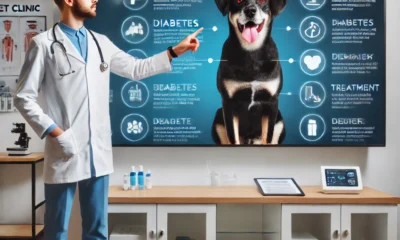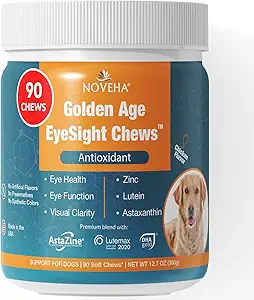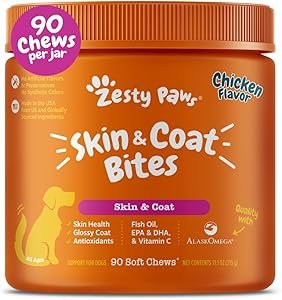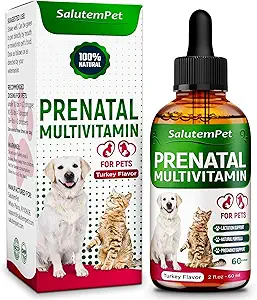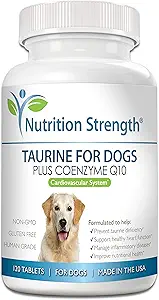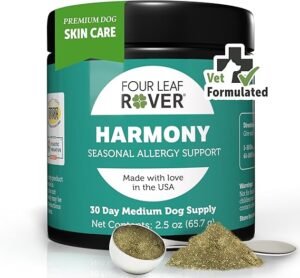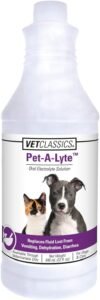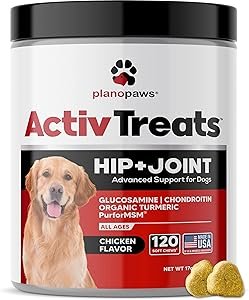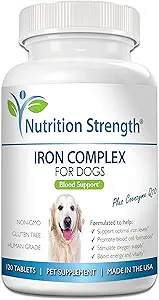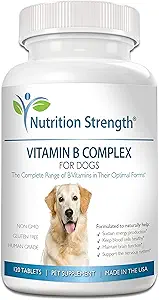Terrier Breeds
Male Black Russian Terrier Potty Training Behavior:
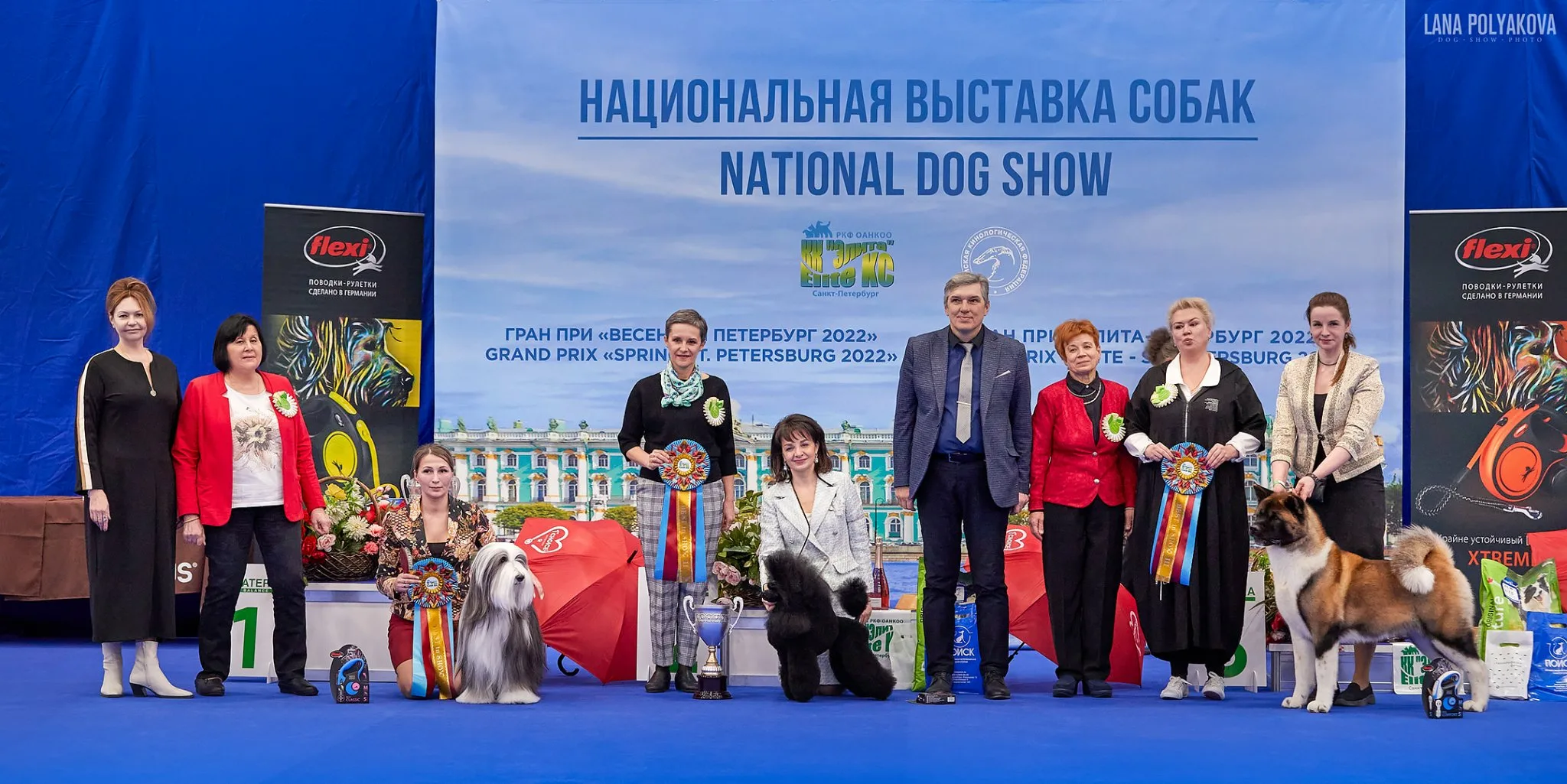
Expert Advice from Renowned Dog Coaches

Male Black Russian Terrier Potty Training Behavior: The (Black Russian Terrier) (BRT), a majestic and intelligent breed, is known for its loyalty, strength, and imposing presence. However, like any other dog breed, proper training and behavior management are essential to ensure they grow into well-rounded companions. Potty training and behavior correction are two critical areas that require attention, especially with this powerful and smart breed. Drawing from the expertise of renowned dog coaches, here’s a comprehensive guide to help you navigate these challenges.
For more information regarding 4 seasonal cxcercieses of all dog breeds recommended by the doctors and experts,you can visit our youtube channel:
https://www.youtube.com/@Dogsreaders
Understanding the Black Russian Terrier

Before diving into training, it’s crucial to understand the breed’s characteristics:
- Intelligence and Trainability: BRTs are highly intelligent, which makes them quick learners. However, their independent streak can sometimes pose a challenge.
- Strong Protective Instincts: Originally bred as guard dogs, BRTs have a natural protective nature. This trait needs to be managed to ensure they’re sociable and well-behaved.
- Energy Levels: BRTs are active dogs that require regular mental and physical stimulation.
Potty Training Your (Black Russian Terrier )-(BRT)

Potty training a BRT, while similar to other breeds, requires consistency and patience. Here’s a step-by-step approach recommended by expert trainers:
1. Establish a Routine

- Take your puppy out at consistent intervals: first thing in the morning, after meals, after naps, and before bedtime.
- Puppies typically need to relieve themselves every 2-3 hours, so plan accordingly.
2. Use a Designated Spot

- Choose a specific potty spot outdoors. Consistently bringing your BRT to the same spot will help them associate the area with relieving themselves.
- The scent of previous trips will act as a natural cue for the dog.
3. Positive Reinforcement

- Reward your puppy immediately after they relieve themselves in the correct spot. Treats, praise, and affection work wonders.
- Avoid punishing accidents indoors; instead, redirect your pup to the designated spot.
4. Monitor and Supervise

- Keep your puppy within your sight when indoors. This allows you to catch early signs of them needing to go, such as sniffing or circling.
- Crate training can also be helpful, as dogs naturally avoid soiling their sleeping area.
5. Clean Accidents Thoroughly

- Use enzymatic cleaners to eliminate odors from accidents. Residual scents can confuse your puppy and lead to repeated mistakes.
Behavior Training for a Well-Mannered Companion

1. Start Early

BRT puppies are impressionable and eager to learn. Begin training as soon as they arrive home to instill good habits early.
2. Socialization

- Introduce your BRT to a variety of people, pets, and environments. This reduces fear and aggression while promoting confidence.
- Organized puppy classes or playgroups are excellent for socializing in a controlled setting.
3. Set Boundaries

- Establish clear rules and be consistent. For example, if you don’t want your dog on the furniture, enforce this rule from day one.
- Use firm but gentle corrections for undesirable behaviors, such as jumping on people or chewing furniture.
4. Leverage Their Intelligence
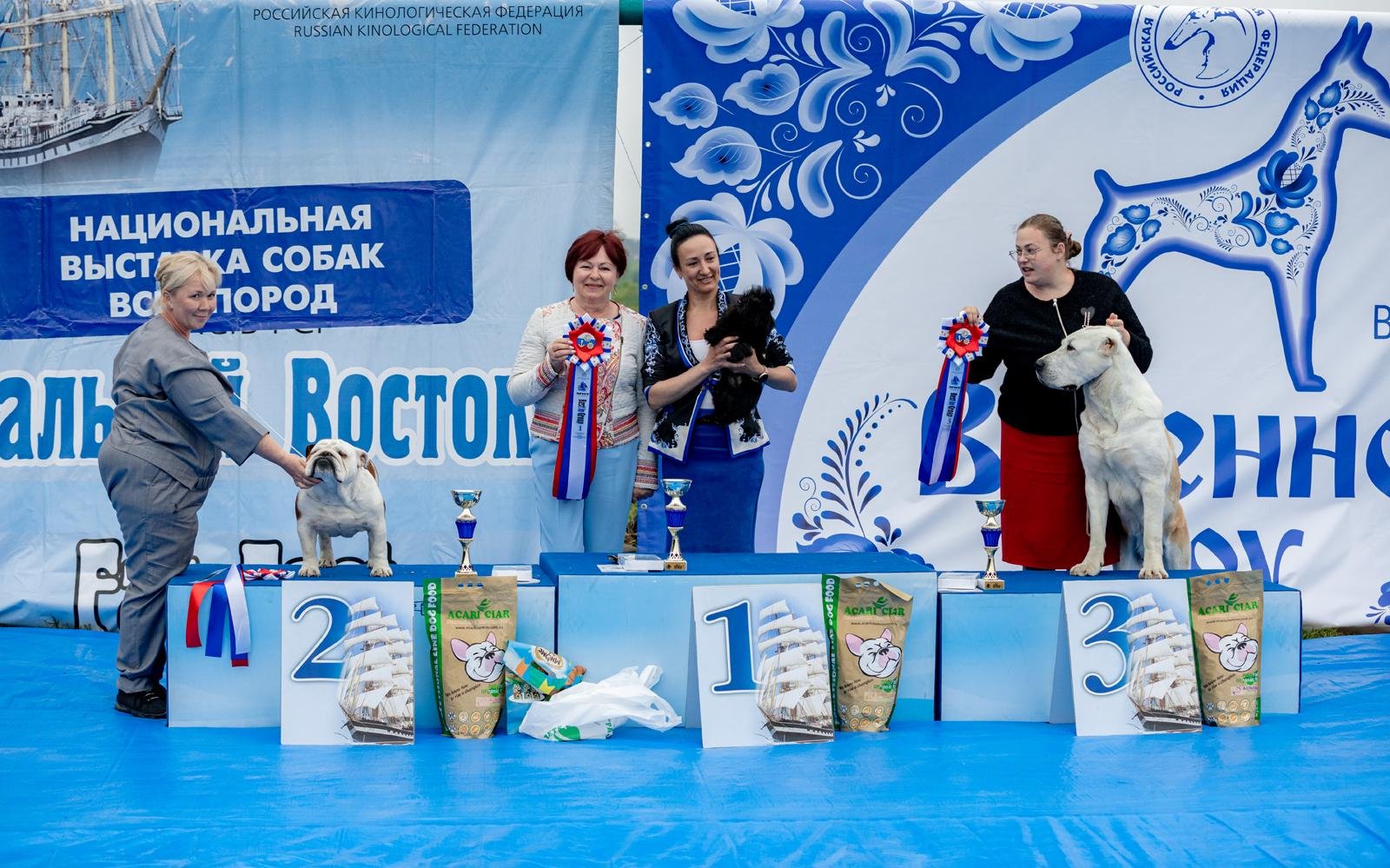
- Provide mental stimulation through puzzle toys, obedience training, and interactive games.
- Teach basic commands like “sit,” “stay,” and “come” before progressing to advanced tasks. This engages their mind and reinforces your role as the leader.
5. Address Aggression and Fear

- BRTs can be wary of strangers due to their protective instincts. Early exposure and controlled introductions can help.
- If aggression persists, consult a professional dog trainer or behaviorist.
Tips from the Pros

Renowned dog coaches emphasize the importance of understanding your dog’s individual personality and needs. Here are some additional tips:
- Patience and Consistency:
- Training takes time, so remain patient and stick to your routine.
- Build Trust:
- A strong bond with your BRT will make training more effective. Spend quality time together, beyond just training sessions.
- Adapt Techniques:
- What works for one dog may not work for another. Be flexible and willing to adjust your approach as needed.
Recent studies and expert analyses have provided valuable insights into the training and behavior of Black Russian Terriers (BRTs). Here’s a summary of the latest findings:
1. Trainability and Intelligence

Black Russian Terriers are recognized for their high intelligence and strong work ethic, making them highly trainable. Their eagerness to learn and please their owners contributes to their success in various training endeavors, from basic obedience to advanced dog sports. However, their independent nature may require experienced handling to ensure successful training outcomes.
2. Importance of Early Socialization

Early and consistent training and socialization are absolutely essential for Black Russian Terriers. Introducing them to a variety of people, pets, and environments during their formative months helps reduce fear and aggression, promoting confidence and well-rounded behavior.
3. Genetic Diversity and Health

Genetic diversity testing has become a useful tool for Black Russian Terrier breeders aiming to track and increase the genetic diversity of the breed. This approach is considered a long-term strategy for maintaining the breed’s health and vitality.
4. Suitability for First-Time Owners

The Black Russian Terrier is not typically recommended for first-time dog owners due to their personality, physical attributes, and potential stubbornness if not properly trained. Prospective owners should be prepared for the commitment required to train and socialize this breed effectively.
These findings underscore the importance of early training, socialization, and responsible breeding practices in ensuring the well-being and proper development of Black Russian Terriers.
Summary

Potty training and behavior management for a Black Russian Terrier are rewarding challenges that can lead to a harmonious life with this extraordinary breed. By following the guidance of expert trainers and investing time and effort, you can ensure your BRT becomes a well-behaved, loyal companion. Remember, training is not just about correcting behavior but also about building a lasting bond with your dog. With the right techniques, your BRT will thrive and bring joy to your household for years to come.

Terrier Breeds
American Staffordshire Terrier: Loyal and Courageous Breed

A Comprehensive Guide
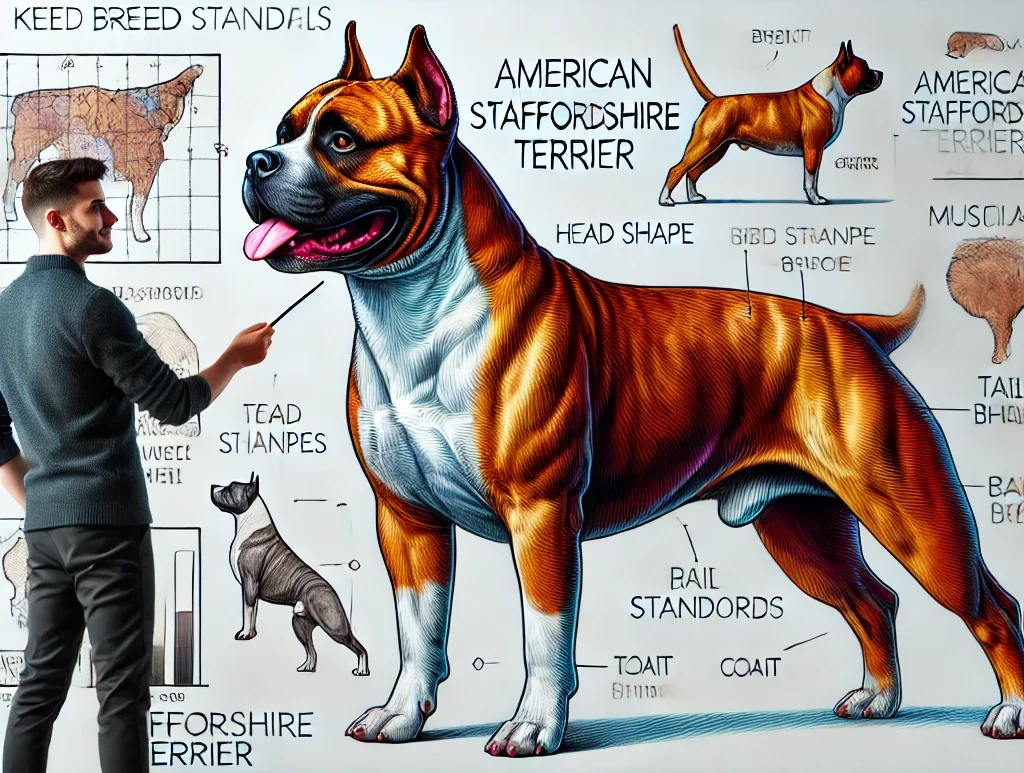
The American Staffordshire Terrier, often referred to as the “AmStaff,” is a strong, loyal, and affectionate breed known for its courage and intelligence. Despite their muscular appearance, AmStaffs are loving companions that thrive in family environments. This article covers the breed’s history, physical characteristics, temperament, grooming needs, exercise requirements, and suitability for families and children.
For more information regarding 4 seasonal cxcercieses of all dog breeds recommended by the doctors and experts,you can visit our youtube channel:
American Staffordshire Terrier Breed Standard
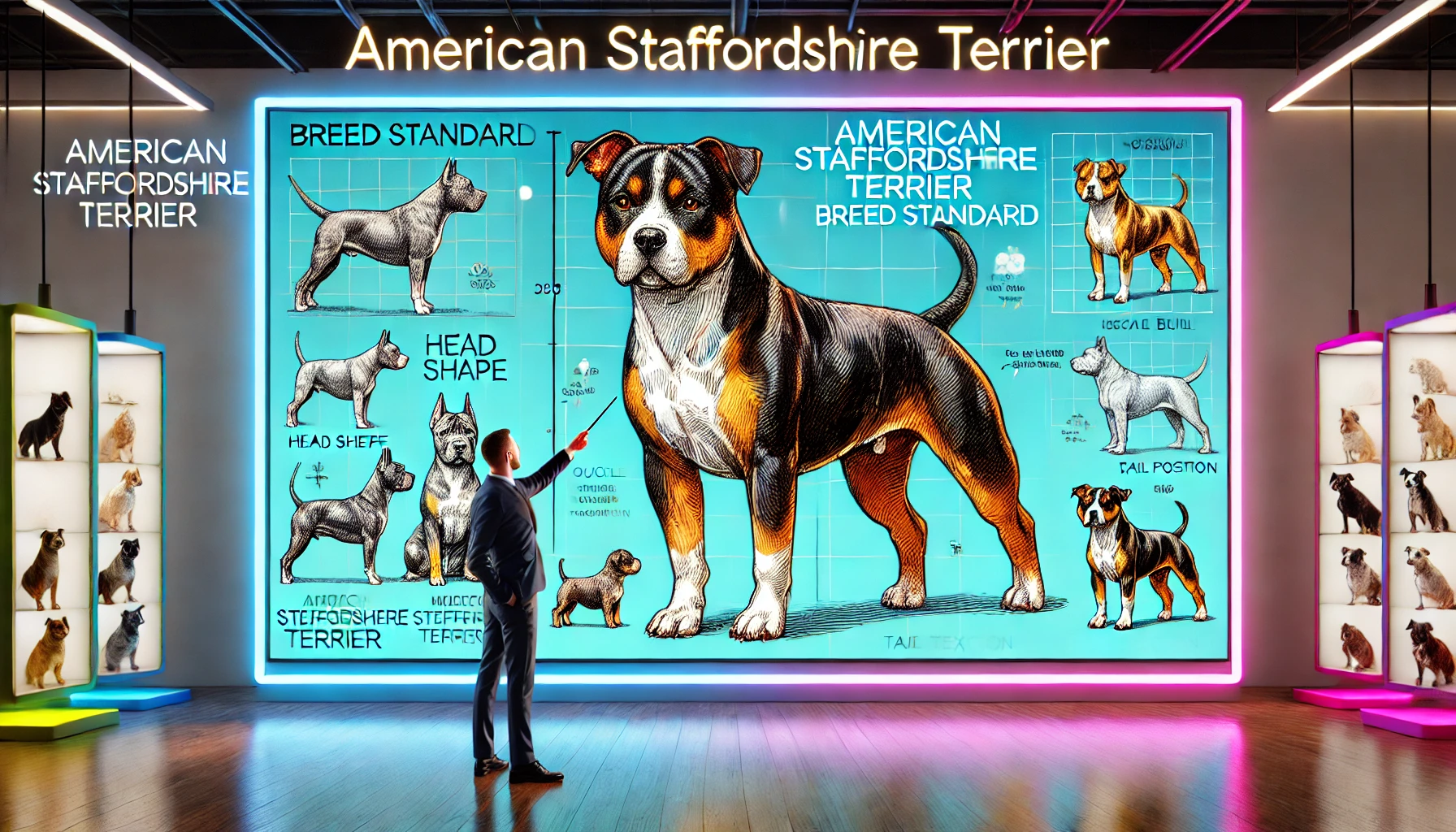
The American Staffordshire Terrier is a muscular, confident, and intelligent breed known for its strength, agility, and affectionate nature. Below is the official breed standard based on recognized kennel clubs like the American Kennel Club (AKC) and the Federation Cynologique Internationale (FCI).
General Appearance

The American Staffordshire Terrier is a well-balanced, powerful dog with a broad skull, strong jaw, and a deep chest. The breed exhibits great strength for its size but is also agile and graceful.
Size & Proportion
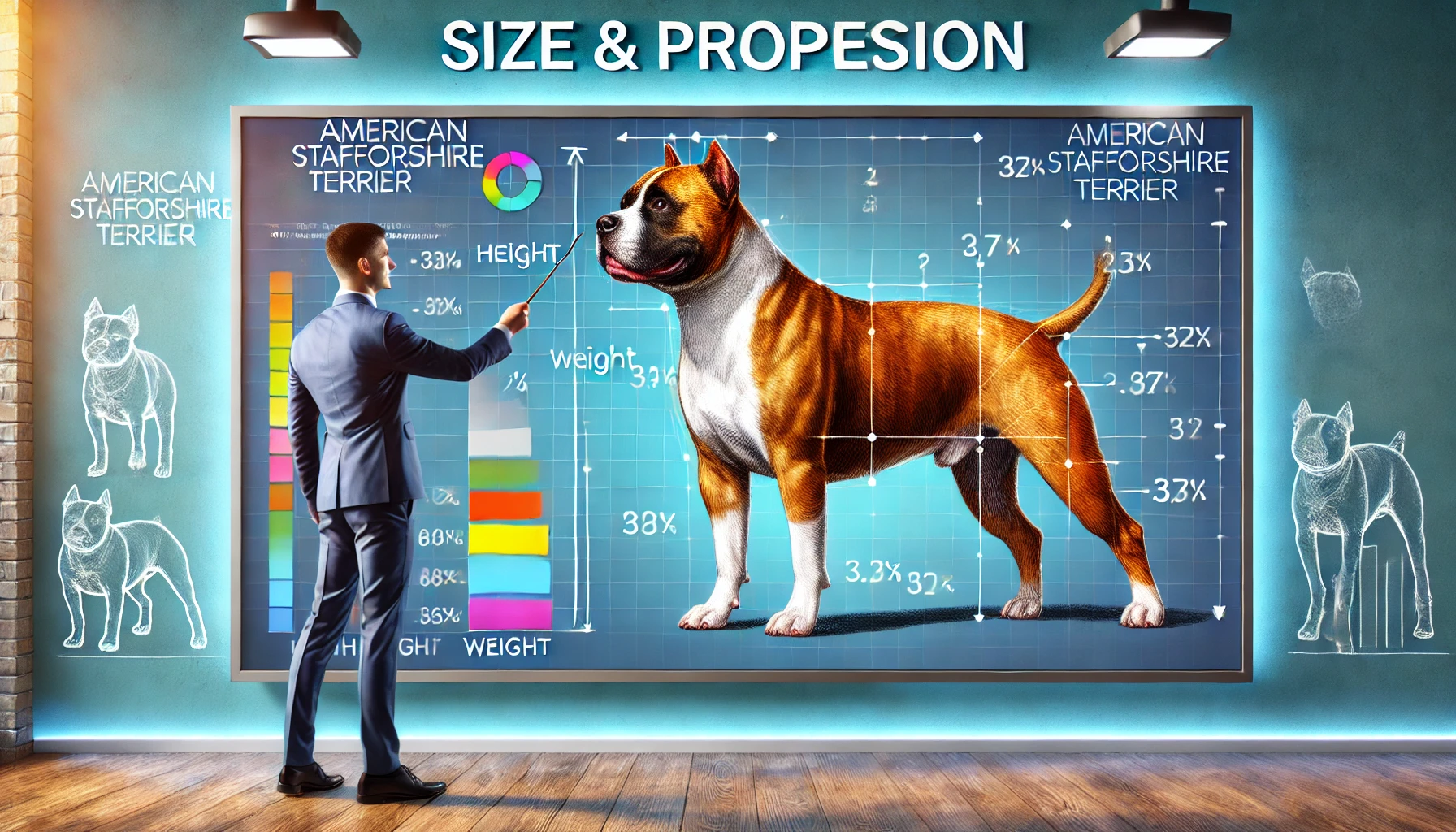
Height:
-
-
Males: 18 to 19 inches (46 to 48 cm) at the shoulder
-
Females: 17 to 18 inches (43 to 46 cm) at the shoulder
-
Weight:
-
-
Typically ranges from 40 to 70 lbs (18 to 32 kg)
-
Proportion:
-
-
Slightly longer than tall, giving a compact and muscular appearance.
-
Head & Skull

- Shape:
- Broad, deep, and well-defined.
- Muzzle:
- Medium length with a well-pronounced stop.
- Nose:
- Always black.
- Jaw Strength:
- Powerful, with well-developed cheek muscles.
- Lips:
- Close-fitting with no looseness.
Eyes
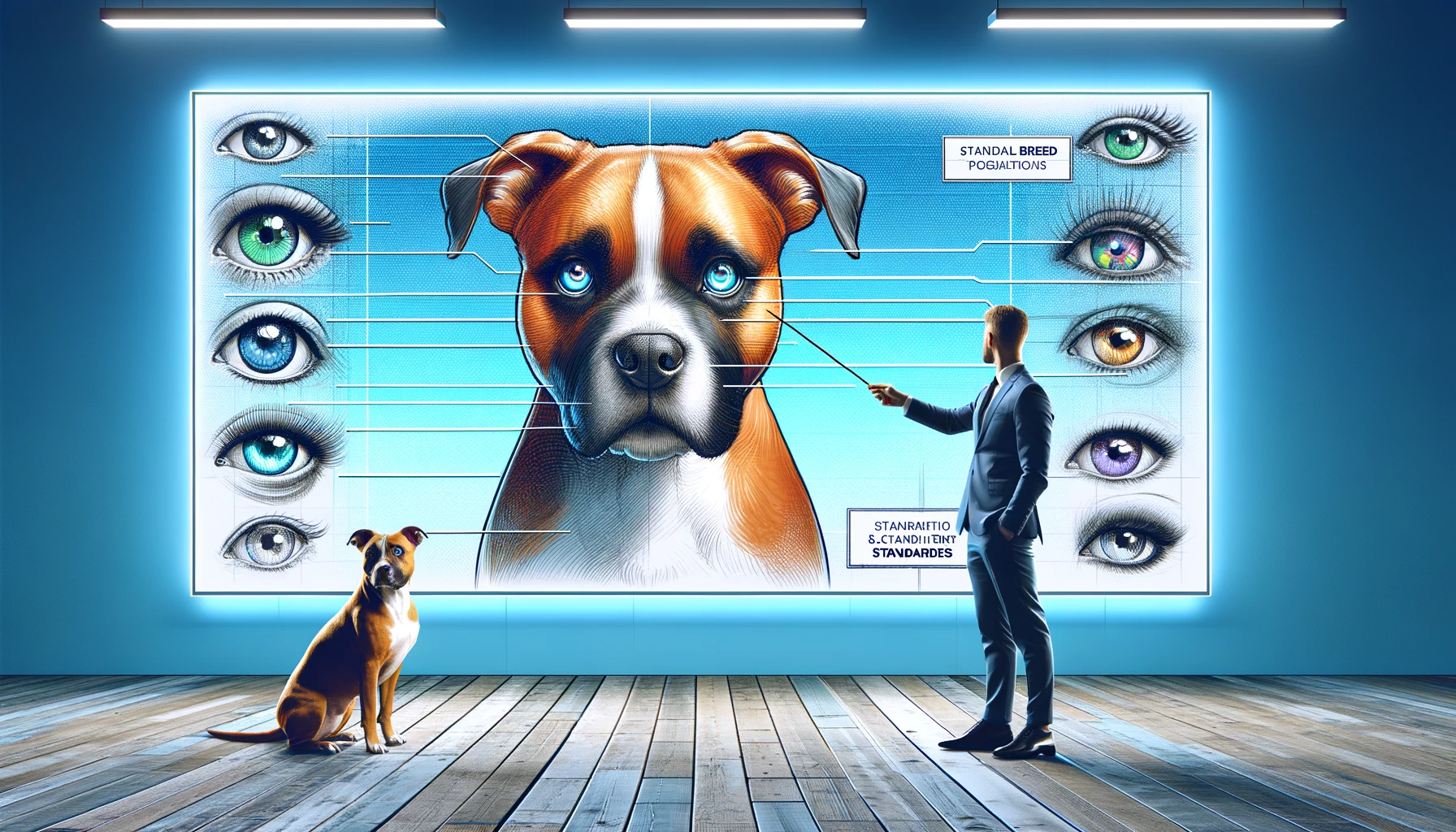
- Shape:
- Round and medium-sized.
- Color:
- Dark, with no light or blue eyes permitted.
- Expression:
- Keen, alert, and confident.
- Placement:
- Set well apart and low on the skull.
Ears

Type:
- Can be cropped or uncropped (natural).
- Preferred:
- Natural ears, which should be half-pricked or rose-shaped.
- Disqualifications:
- Full drop ears.
Body
- Neck:
- Heavy, slightly arched, tapering from the shoulders to the base of the skull.
- Chest:
- Deep and broad, with well-sprung ribs.
- Back:
- Short and strong with a slight slope from withers to rump.
- Loins:
- Slightly tucked up.
Forequarters & Hindquarters
- Forelegs:
- Straight and well-boned. Shoulders are strong and muscular.
- Hindquarters:
- Well-muscled with strong, parallel hind legs.
- Feet:
- Compact and well-arched.
- Tail:
- Short, low-set, and tapering to a fine point. Should never be docked.
Coat & Color
- Coat Type:
- Short, close-fitting, and glossy.
- Texture:
- Stiff but smooth to the touch.
- Colors:
- Accepted Colors:
- Solid, patched, or parti-color.
- Disqualifications:
- Solid white, black and tan, or liver color.
Movement & Gait
- Gait:
- Free, confident, and springy with a strong drive from the hindquarters.
- Overall Balance:
- Must be smooth and well-coordinated.
Temperament
- Personality:
- Confident, good-natured, and highly affectionate with family.
- Social Behavior:
- Friendly with humans but may be territorial with other dogs.
- Trainability:
- Intelligent and eager to please but requires firm and consistent training.
Disqualifications
-
Pink or liver-colored nose.
-
Blue or light-colored eyes.
-
Excessively long or curly coat.
-
Docked tail.
-
Height exceeding the standard limits.
This breed standard ensures that the American Staffordshire Terrier retains its original working capabilities, physical prowess, and loving temperament while maintaining its recognized appearance.
Brief History of the American Staffordshire Terrier
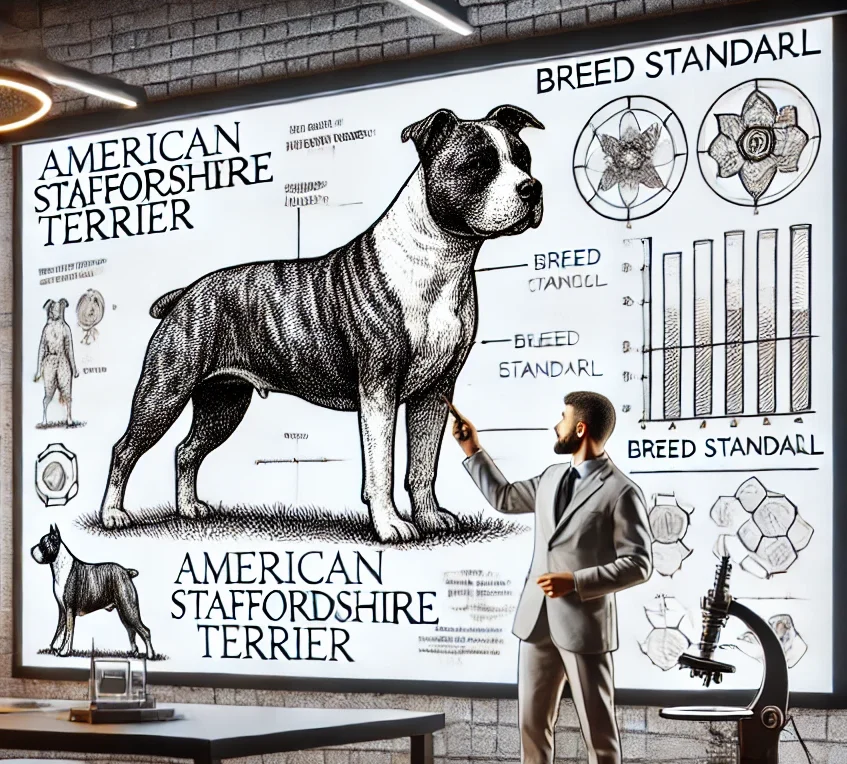
- Origin:
- Developed in the 19th century in the United States, descended from the Staffordshire Bull Terrier and other bulldog and terrier breeds.
- Purpose:
- Originally bred for bull-baiting and dog fighting, but later refined into a loyal companion and working dog.
- Recognition:
- Officially recognized by the American Kennel Club (AKC) in 1936.
- Modern Role:
- Known for their versatility as family pets, therapy dogs, and competitors in dog sports like agility and obedience.
Physical Characteristics
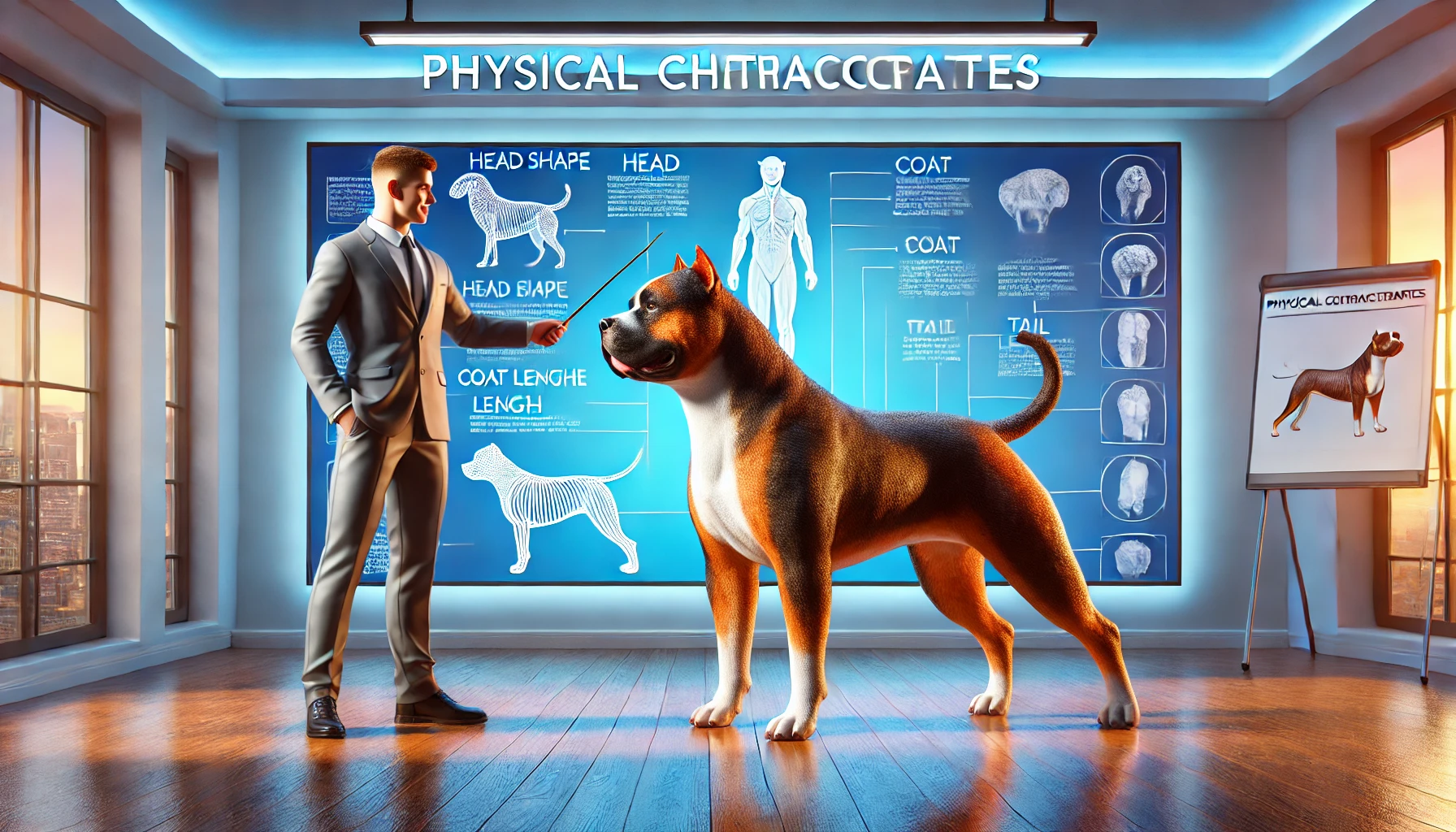
- Height:
- 17-19 inches (43-48 cm) at the shoulder.
- Weight:
- 40-70 pounds (18-32 kg).
- Coat:
- Short, smooth, and glossy.
- Colors:
- Wide variety, including black, blue, brindle, fawn, red, and white.
- Build:
- Muscular and stocky with a broad head and strong jaws.
Temperament and Personality
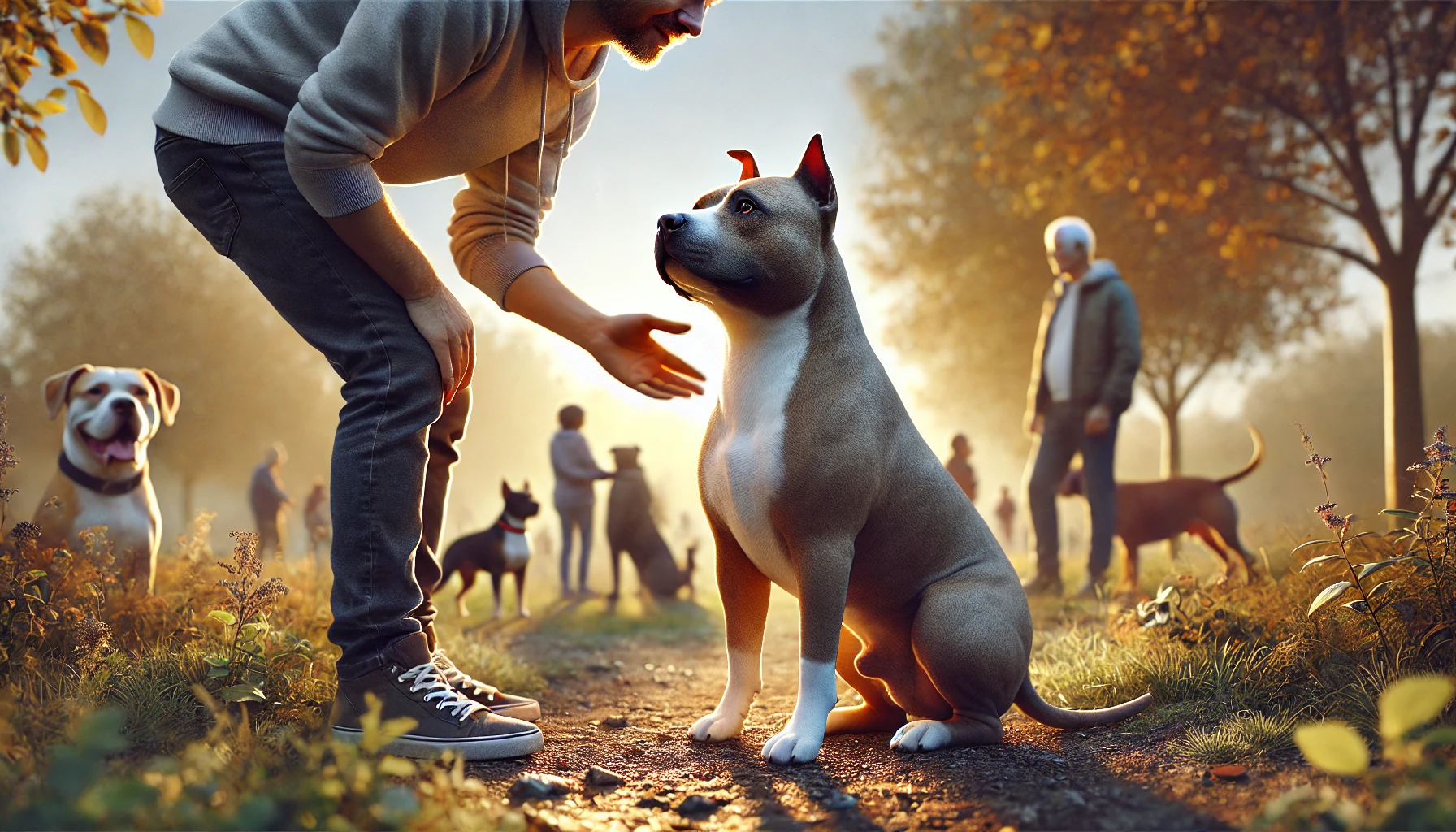
- Loyal:
- Deeply devoted to their families.
- Courageous:
- Fearless and confident.
- Affectionate:
- Love to cuddle and be close to their owners.
- Intelligent:
- Quick learners but can be stubborn.
- Playful:
- Enjoy games and activities with their families.
Grooming Needs
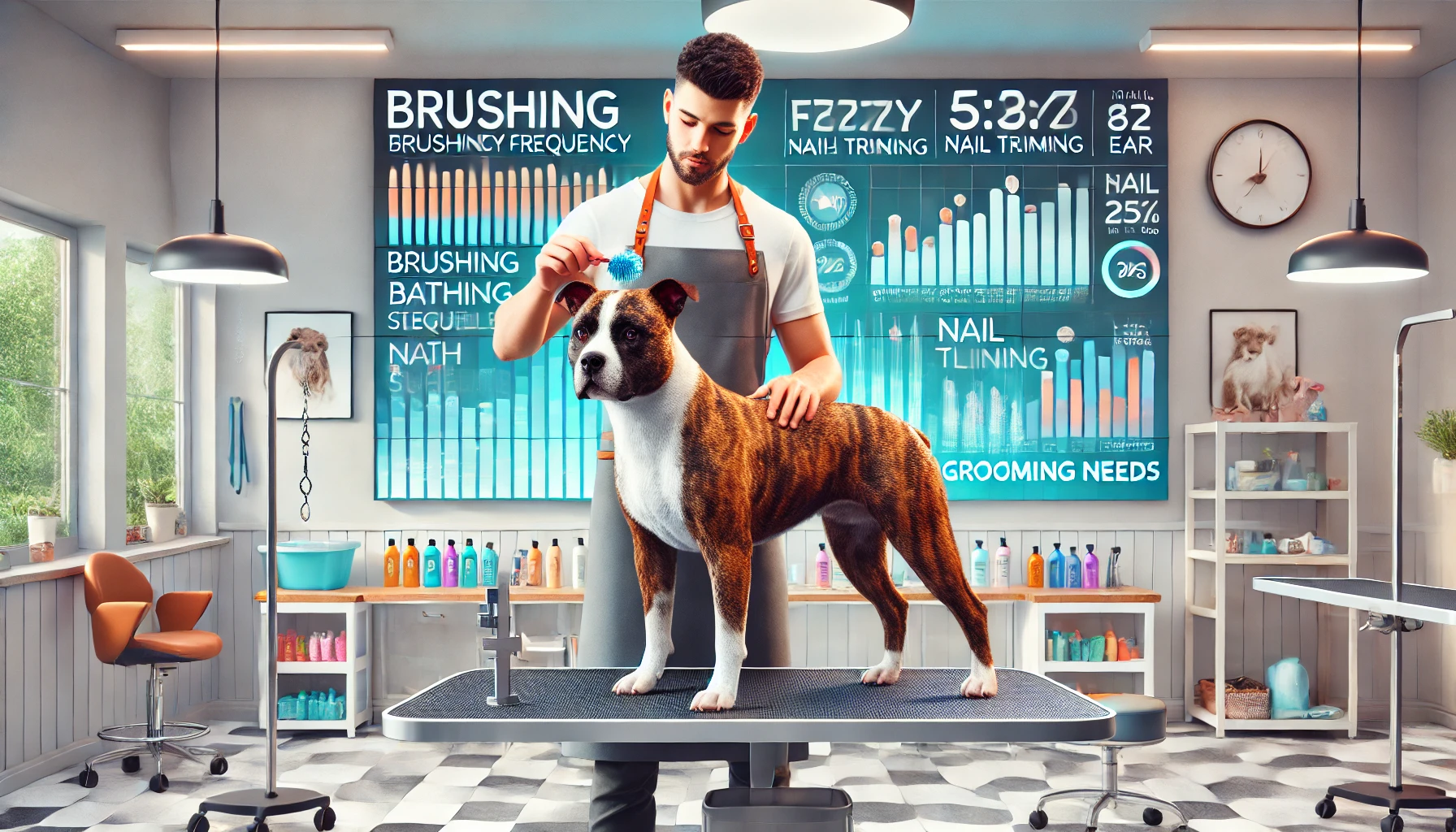
- Coat Care:
- Weekly brushing with a soft-bristle brush to remove loose hair and maintain shine.
- Bathing:
- Bathe every 6-8 weeks or as needed.
- Ears:
- Clean ears weekly to prevent infections.
- Nails:
- Trim nails every 2-3 weeks.
- Teeth:
- Brush teeth 2-3 times a week to maintain oral health.
Seasonal Supplements for American Staffordshire Terrier


Key Supplements for Pregnant American Staffordshire Terriers
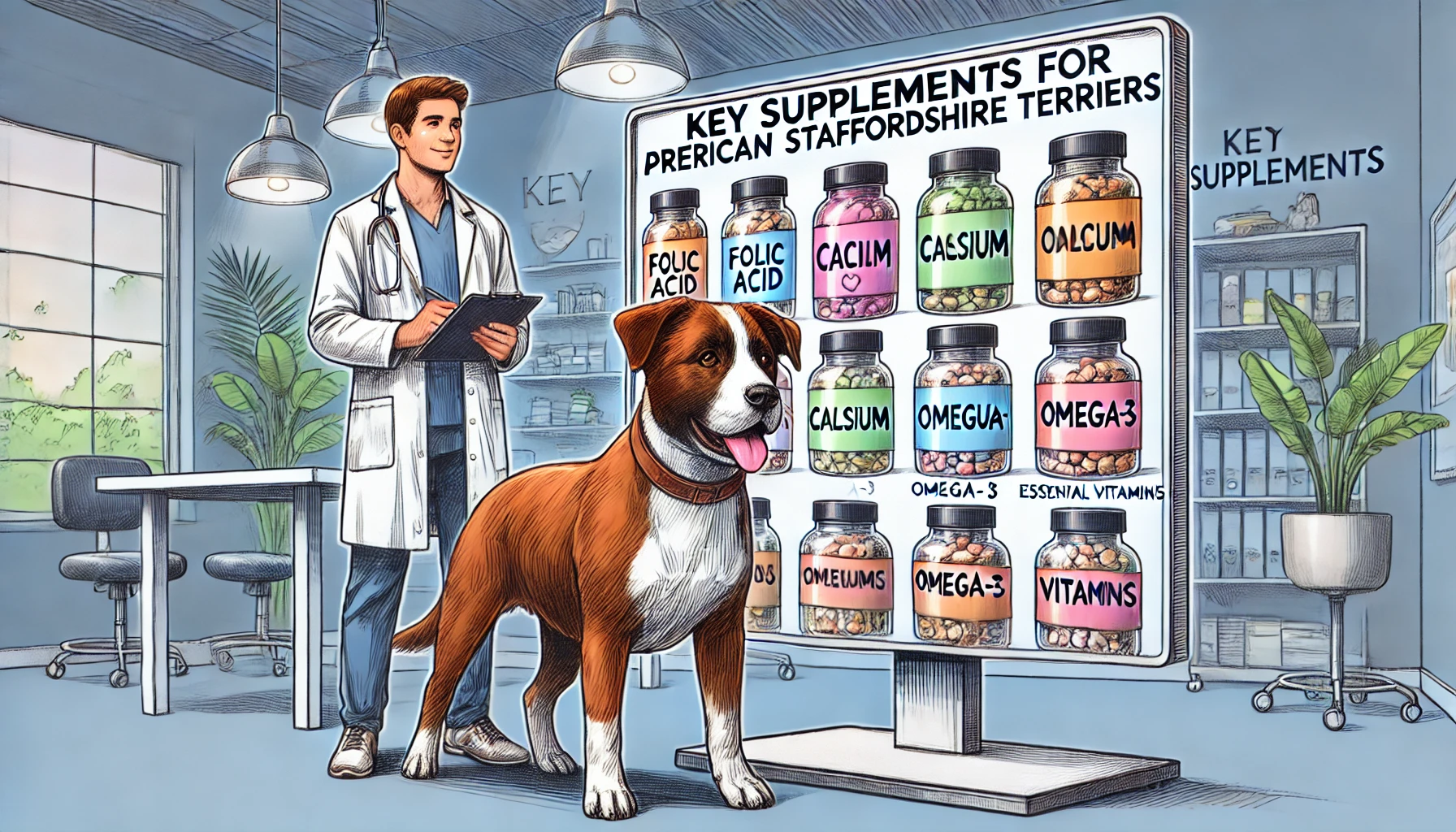
Notes:
Consult your vet before adding any supplements to ensure correct dosages based on individual health needs.
Avoid excessive calcium intake in early pregnancy as it can lead to developmental issues. Introduce calcium after week 6 for proper lactation support.
Hydration is key—ensure the mother drinks plenty of clean, fresh water throughout pregnancy.
Exercise Requirements

- Daily Exercise:
- At least 60-90 minutes of vigorous activity, such as walking, running, or playing fetch.
- Mental Stimulation:
- Engage in activities like obedience training, puzzle toys, or agility courses.
- Socialization:
- Regular interaction with people and other dogs to maintain good behavior.
Family and Child Friendliness

- Family-Friendly:
- AmStaffs are affectionate and thrive in family environments.
- Child-Friendly:
- Gentle and patient with children, making them excellent playmates.
- Other Pets:
- Can get along with other pets if socialized early, but supervision is recommended due to their strong prey drive.
Health and Lifespan
- Life Span: 12-16 years.
- Common Health Issues:
-
- Hip dysplasia.
- Skin allergies.
- Heart conditions.
- Hypothyroidism.
Training and Socialization
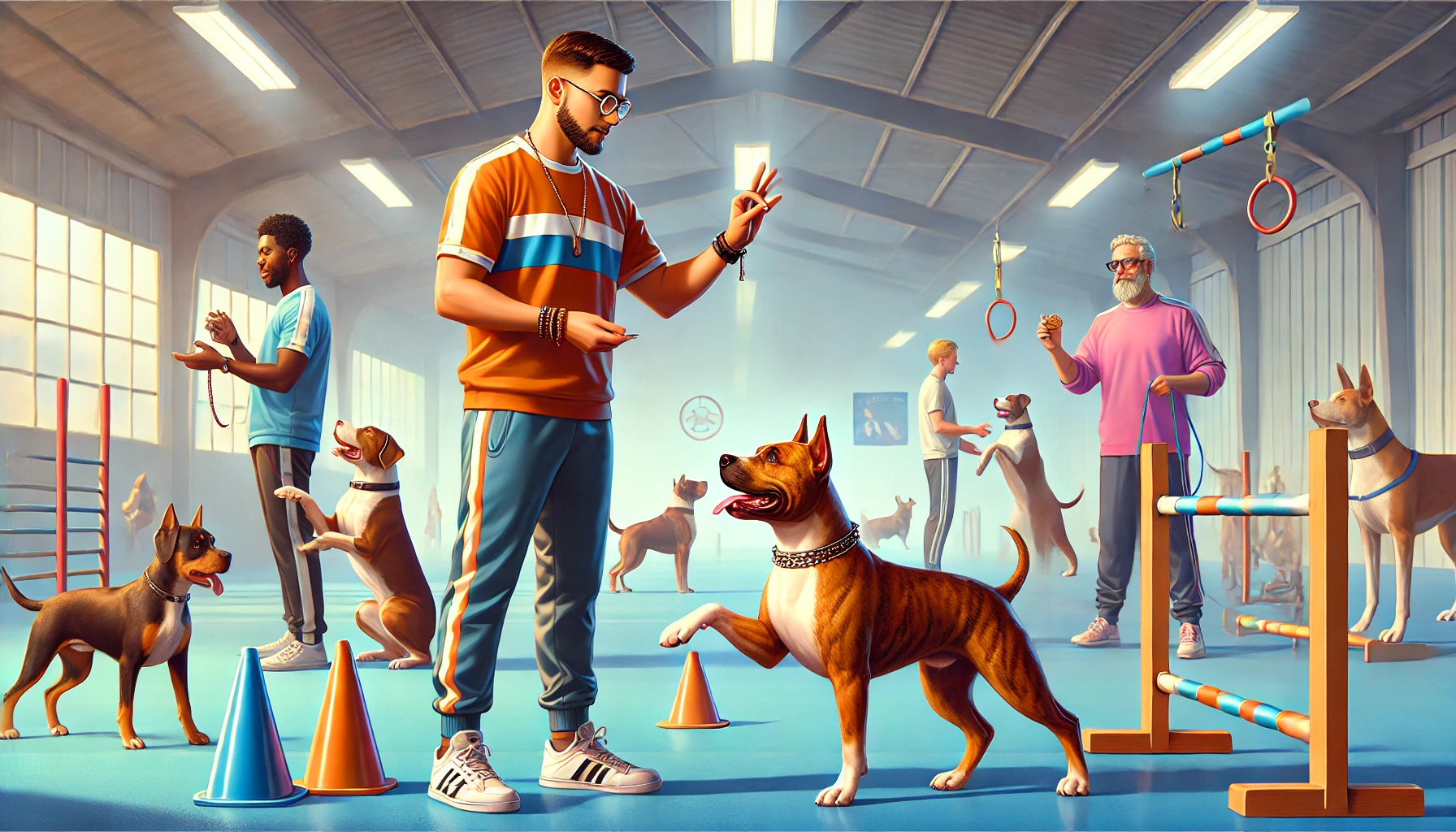
- Training:
- AmStaffs are intelligent but can be stubborn. Use positive reinforcement techniques for best results.
- Socialization:
- Early and consistent socialization is crucial to ensure they are well-behaved around people and other animals.
Closing Statement
The American Staffordshire Terrier is a loyal, courageous, and affectionate breed that makes an excellent companion for active families. With proper training, socialization, and care, AmStaffs can thrive in various environments and roles. Whether you’re looking for a loving family pet or a competitive sports dog, the American Staffordshire Terrier is a versatile and devoted choice.
(FAQs) About American Staffordshire Terriers

Below are detailed answers to common questions about American Staffordshire Terriers, including their temperament, care, and suitability as family pets.
1. What is an American Staffordshire Terrier?
The American Staffordshire Terrier, or AmStaff, is a muscular, loyal, and affectionate breed known for its courage and intelligence. It is a versatile companion and working dog.
2. Are American Staffordshire Terriers good with children?
Yes, AmStaffs are gentle and patient with children, making them excellent family pets. However, supervision is recommended due to their strength and energy.
3. How much exercise does an American Staffordshire Terrier need?
AmStaffs need 60-90 minutes of vigorous exercise daily, including walks, playtime, and mental stimulation.
4. Are American Staffordshire Terriers easy to train?
AmStaffs are intelligent but can be stubborn. They respond best to consistent, positive reinforcement training methods.
5. Do American Staffordshire Terriers shed?
Yes, AmStaffs have a short, smooth coat that sheds moderately. Weekly brushing can help manage shedding.
6. Are American Staffordshire Terriers good with other pets?
AmStaffs can get along with other pets if socialized early, but supervision is recommended due to their strong prey drive.
7. What is the life span of an American Staffordshire Terrier?
The average life span of an AmStaff is 12-16 years.
8. Do American Staffordshire Terriers bark a lot?
AmStaffs are not excessive barkers but may bark to alert their owners or when excited.
9. Are American Staffordshire Terriers hypoallergenic?
No, AmStaffs are not hypoallergenic. They shed moderately and may not be suitable for people with severe allergies.
10. What colors do American Staffordshire Terriers come in?
AmStaffs come in a variety of colors, including black, blue, brindle, fawn, red, and white.
11. Are American Staffordshire Terriers good for first-time owners?
AmStaffs can be challenging for first-time owners due to their strong-willed nature. They are better suited for experienced dog owners.
12. How often should I groom my American Staffordshire Terrier?
Brush their coat weekly to remove loose hair.
Bathe them every 6-8 weeks.
Clean their ears and trim their nails weekly.
13. Can American Staffordshire Terriers live in apartments?
AmStaffs can adapt to apartment living if they receive sufficient exercise and mental stimulation. However, they thrive in homes with access to a yard.
14. Do American Staffordshire Terriers have health issues?
AmStaffs may be prone to:
Hip dysplasia.
Skin allergies.
Heart conditions.
Hypothyroidism.
15. Are American Staffordshire Terriers good watchdogs?
Yes, AmStaffs are alert and protective, making them good watchdogs.
16. How much does an American Staffordshire Terrier cost?
The cost of an AmStaff puppy ranges from between $500 and $2,000, depending on the breeder and lineage.
17. Do American Staffordshire Terriers need supplements?
Supplements like omega-3 fatty acids and joint support formulas can benefit their overall health. Always consult your vet before starting supplements.
18. Are American Staffordshire Terriers good for seniors?
AmStaffs are energetic and strong, making them better suited for active individuals rather than seniors.
19. Can American Staffordshire Terriers be left alone?
AmStaffs are social dogs and may develop destructive behaviors if left alone for long periods. They thrive in homes where they receive plenty of attention.
20. What is the difference between an American Staffordshire Terrier and a Pit Bull?
American Staffordshire Terrier: Recognized by the AKC, slightly larger, and bred for conformation shows and companionship.
Pit Bull: A broader term that includes several breeds, such as the American Pit Bull Terrier, and is not recognized by the AKC.
Terrier Breeds
Bull Terrier: Playful Gladiator Latest
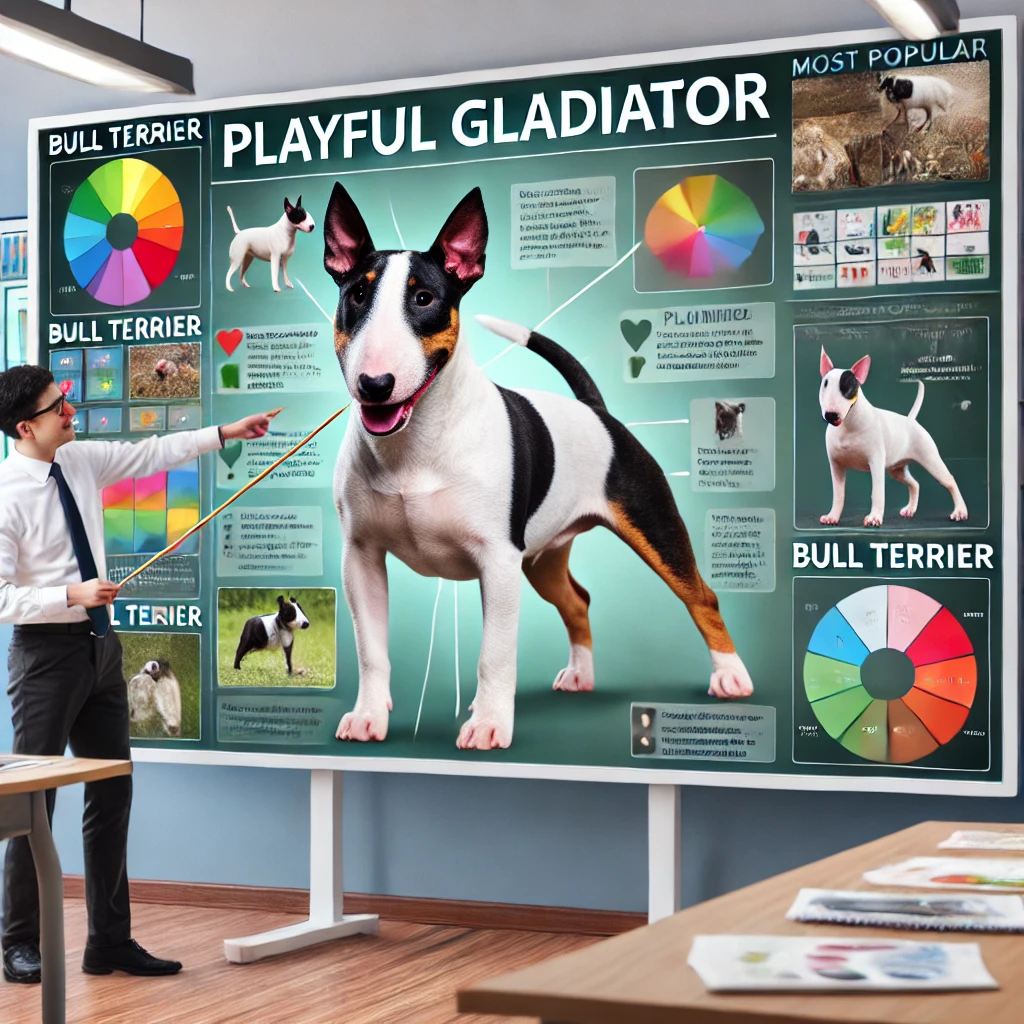
Loyal and Energetic Companion
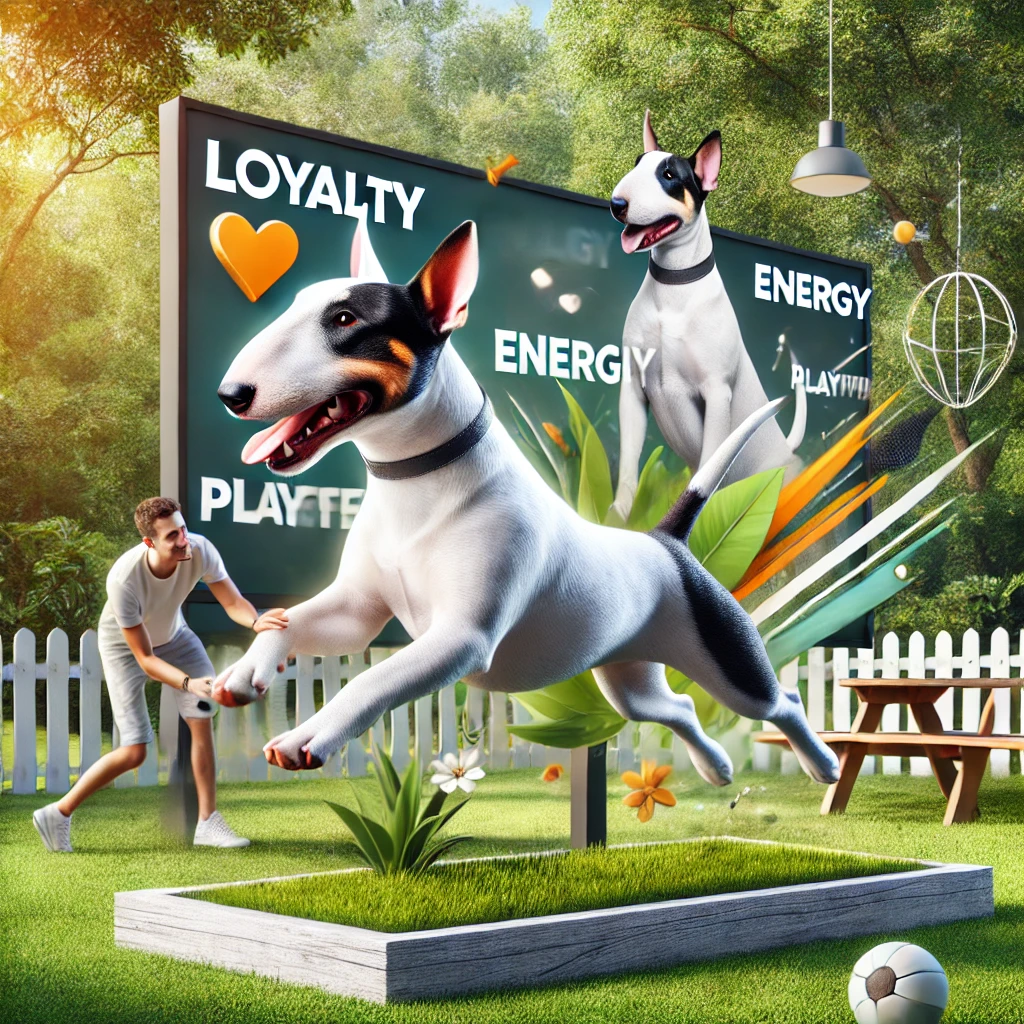
The Bull Terrier originated in England in the 19th century. It was initially bred for bull-baiting and later dog fighting, but after the sport was banned, breeders refined the Bull Terrier into a loyal companion. The breed was developed by crossing the Bulldog with the Old English Terrier, later mixed with Spanish Pointers for agility. Over time, the aggressive nature was bred out, making the Bull Terrier a devoted, fun-loving family pet. Today, the breed is recognized by major kennel clubs worldwide, including the American Kennel Club (AKC), United Kennel Club (UKC), and the Fédération Cynologique Internationale (FCI).
For more information regarding 4 seasonal cxcercieses of all dog breeds recommended by the doctors and experts,you can visit our youtube channel:
Bull Terrier Breeds & Colors by Country
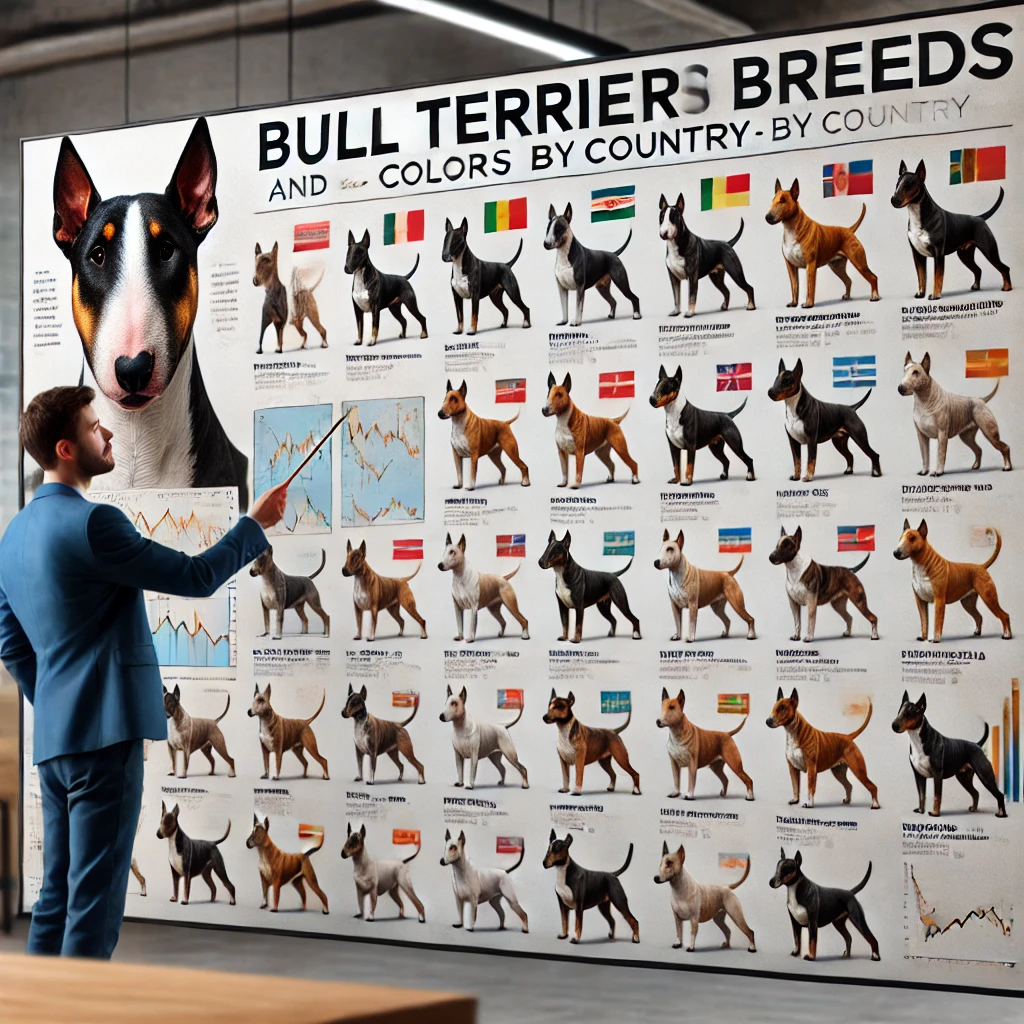
Bull Terriers are found in various breeds and colors across different countries. The Miniature Bull Terrier is a recognized variation. Below is a table summarizing country-wise availability and common color variations:
Bull Terrier Color Variations by Country
| Country | Breed Type | Common Colors |
|---|---|---|
| United States | Standard & Miniature | White, Brindle, Red, Black & Tan |
| United Kingdom | Standard & Miniature | White, Fawn, Tricolor, Brindle |
| Canada | Standard & Miniature | Black, White, Red, Fawn, Brindle |
| Germany | Standard & Miniature | Solid White, Red, Fawn, Brindle |
| Australia | Standard & Miniature | Brindle, White, Fawn, Red |
| France | Standard Only | White, Tricolor, Brindle |
| Russia | Standard & Miniature | White, Red, Black & Tan |
Male vs. Female Bull Terrier Differences

| Feature | Male Bull Terrier | Female Bull Terrier |
|---|---|---|
| Height | 21-22 inches (53-56 cm) | 20-21 inches (50-53 cm) |
| Weight | 55-65 lbs (25-30 kg) | 45-55 lbs (20-25 kg) |
| Temperament | More playful, energetic, and dominant | Slightly calmer, more independent |
| Trainability | Requires firm training due to stubbornness | Easier to train but still stubborn |
| Physical Build | More muscular and broad | Leaner and slightly smaller |
Physical Characteristics
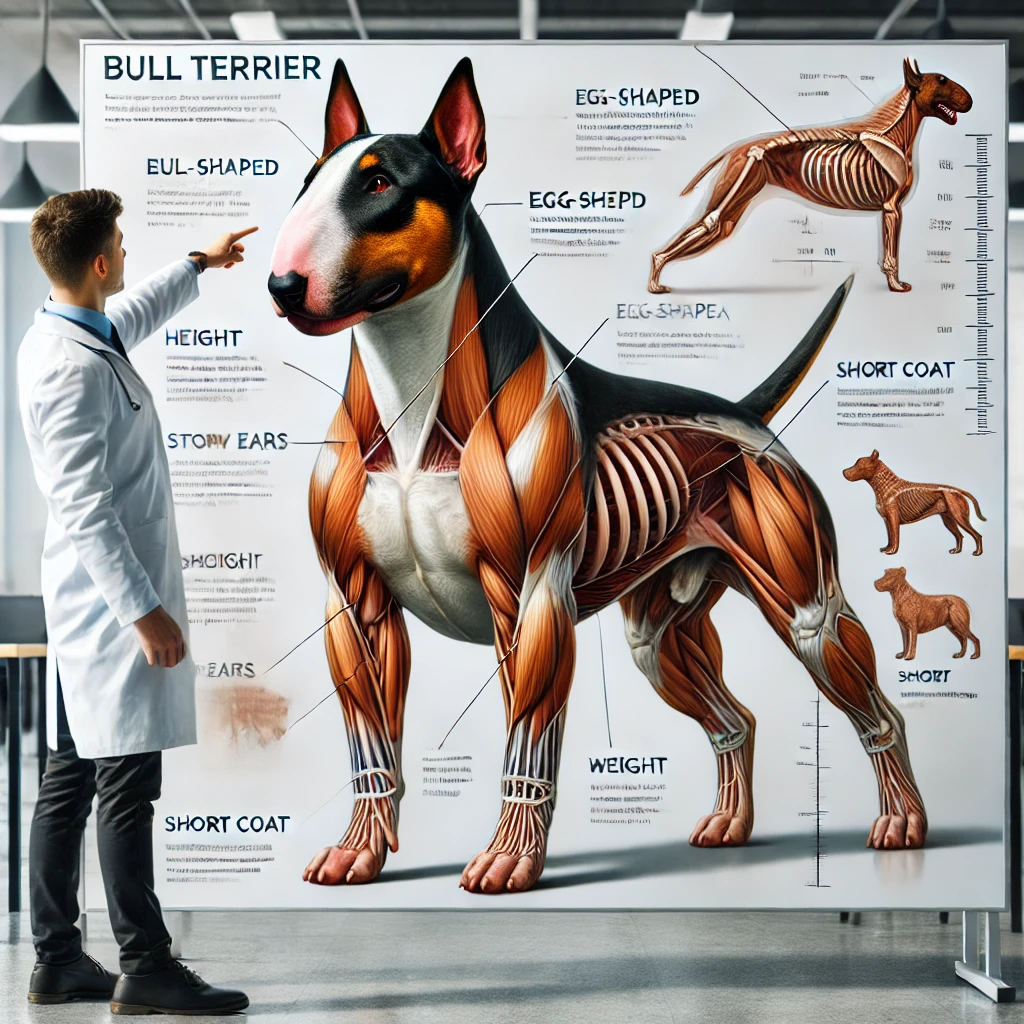
- Head Shape:
- Egg-shaped with a convex profile
- Eyes:
- Small, triangular, and deep-set
- Ears:
- Small, erect, and pointed
- Coat Type:
- Short, dense, and glossy
- Tail:
- Medium length, carried horizontally
Personality & Temperament

The Bull Terrier is known for its bold, mischievous, and playful nature. They are extremely loyal and protective, making them great guard dogs. However, they can also be very stubborn and independent, requiring strong leadership from an owner.
Key Traits:

Highly energetic and playful
Extremely loyal and protective
Can be stubborn; requires firm training
Affectionate with family but wary of strangers
Gets along with children but needs supervision
Grooming Needs

Bull Terriers have a low-maintenance coat, but regular grooming is still required.
- Brushing:
- Once or twice a week with a rubber mitt
- Bathing:
- Once every 1-2 months or when dirty
- Nail Clipping:
- Every 2-3 weeks
- Ear Cleaning:
- Once a week
- Dental Care:
- Brush teeth 2-3 times a week
Exercise Needs (Male, Female & Pregnant)
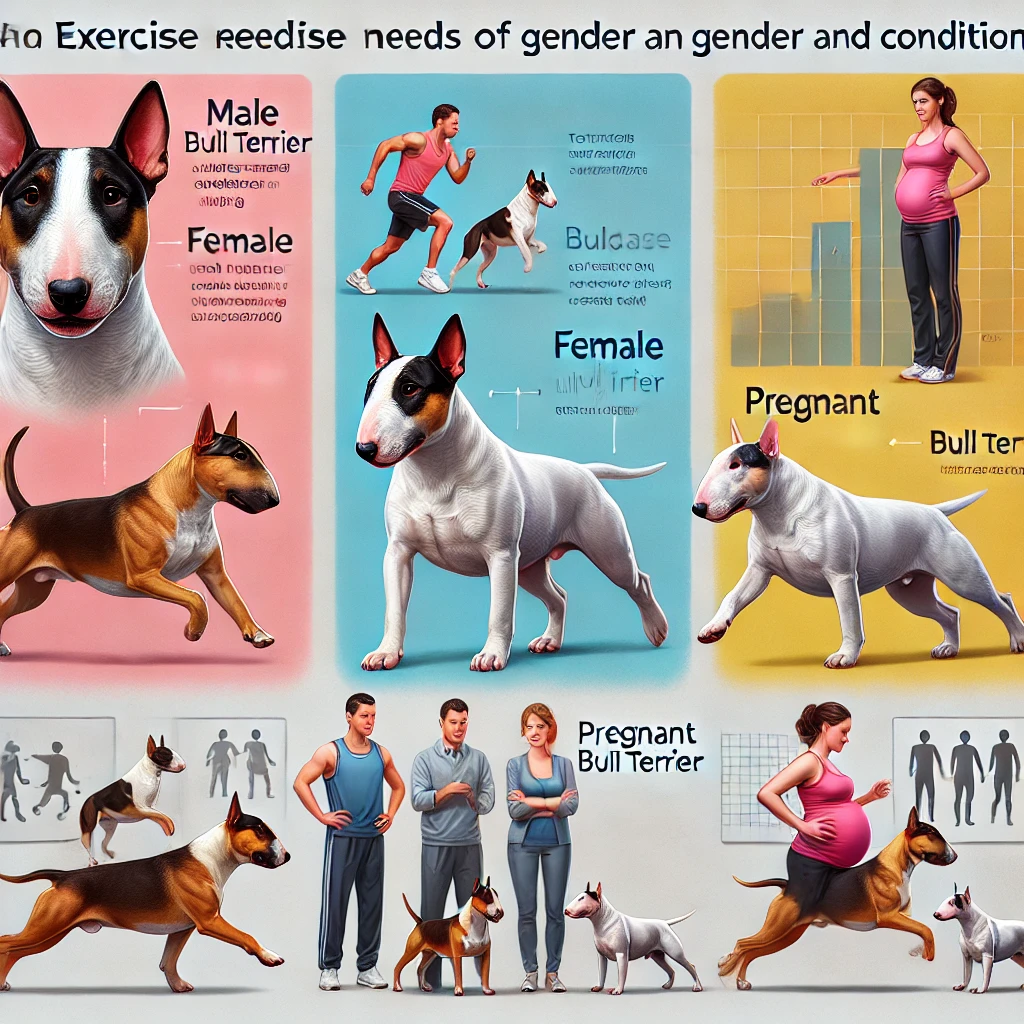
| Category | Exercise Requirement |
|---|---|
| Male Bull Terrier | 60-90 minutes daily (walks, runs, playtime) |
| Non-Pregnant Female | 60 minutes daily (moderate play and walking) |
| Pregnant Female | 30 minutes of light exercise (short walks, no jumping) |
Bull Terriers need a lot of physical activity to stay mentally and physically fit. Lack of exercise can lead to destructive behaviors like chewing and digging.
Common Habits of the Bull Terrier

- Loves to chew:
- Provide durable chew toys
- Playful and energetic:
- Needs daily interaction
- Protective instincts:
- Naturally guards family members
- Tendency to chase:
- May not be ideal around small pets
- Digs and burrows:
- Provide a designated digging spot
Bull Terriers & Family Compatibility

Bull Terriers can be excellent family dogs but require early socialization.
- Great with children –
- Supervision is needed with younger kids
- Protective nature –
- Excellent watchdogs
- May not get along with other pets –
- Requires early socialization
- Best suited for active families
- who can meet their exercise needs
Seasonal Supplements for Bull Terriers

| Season | Recommended Supplements |
|---|---|
| Winter | Omega-3 (fish oil),
|
| Summer | Hydration supplements,
|
| Spring | Allergy relief (quercetin),
|
| Autumn | Joint care,
|
Supplements for Pregnant Female Bull Terriers

| Nutrient | Importance | Recommended Sources |
|---|---|---|
| Folic Acid | Prevents birth defects
|
Green veggies, Supplements |
| Calcium | Supports strong bones
|
Dairy, Bone meal, Supplements |
| Iron | Prevents anemia
|
Liver, Red meat, Supplements |
| Omega-3 Flaxseed | Develops puppies’ brain & vision
|
Fish oil, Flaxseed |
Essential Supplements for Common Health Issues Deafness Male & Female Bull Terriers

| Health Concern | Recommended Supplements | Benefits |
|---|---|---|
| Deafness (Common in White Bull Terriers) | Omega-3 Fatty Acids (Fish Oil) | Supports brain health and may improve cognitive function in partially deaf dogs. |
| Vitamin B Complex | Helps with nerve function and may support hearing health. | |
| Skin Allergies & Sensitivities | Omega-6 Fatty Acids | Helps reduce inflammation and improves skin health. |
| Probiotics | Supports gut health, reducing allergy triggers and itchy skin issues. | |
| Zinc Supplements | Essential for skin repair and reducing dermatitis. | |
| Heart Health Issues | Taurine | Supports heart muscle function and prevents dilated cardiomyopathy. |
| L-Carnitine | Enhances energy metabolism and supports a strong heart. | |
| Kidney Problems | Cranberry Extract | Helps prevent urinary tract infections (UTIs), which are common in dogs with kidney issues. |
| Low-Phosphorus Diet Supplements | Reduces kidney strain and slows kidney disease progression. |
Closing Statement

The Bull Terrier is a unique, energetic, and loving breed, perfect for active families who can provide proper training, exercise, and care. Whether you’re considering getting one or already own a Bull Terrier, understanding their needs will ensure a happy and healthy life for your pup
(FAQs) About Bull Terriers
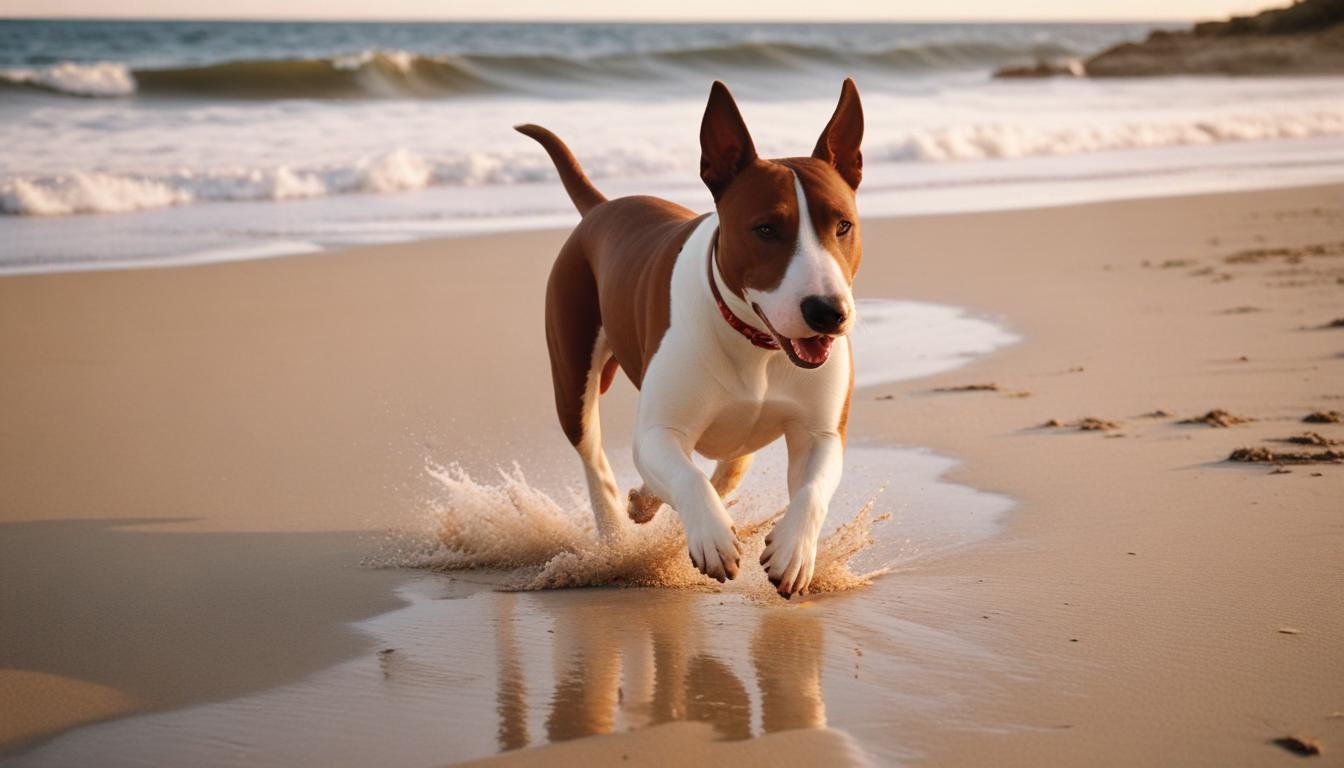
Below are detailed answers to common questions about Bull Terriers, including their temperament, care, and suitability as family pets.
1. What is a Bull Terrier?
The Bull Terrier is a muscular, energetic, and playful breed known for its distinctive egg-shaped head and strong personality. It is a loyal and affectionate companion.
2. Are Bull Terriers good with children?
Yes, Bull Terriers are generally good with children, especially when raised together. However, supervision is recommended due to their strong and energetic nature.
3. How much exercise does a Bull Terrier need?
Bull Terriers need 60-90 minutes of vigorous exercise daily, including walks, playtime, and mental stimulation.
4. Are Bull Terriers easy to train?
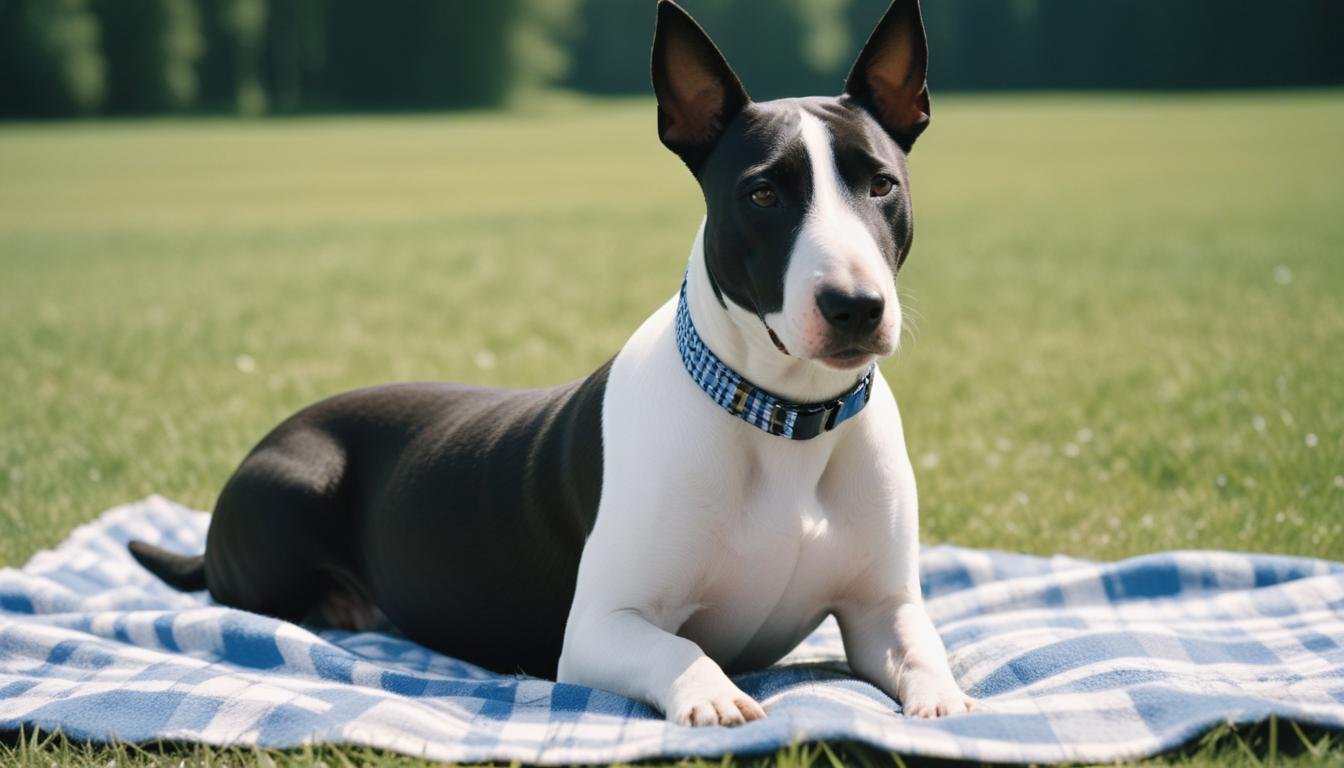
Bull Terriers are intelligent but can be stubborn. They respond best to consistent, positive reinforcement training methods.
5. Do Bull Terriers shed?
Yes, Bull Terriers have a short, flat coat that sheds moderately. Weekly brushing can help manage shedding.
6. Are Bull Terriers good with other pets?
Bull Terriers can be dog-aggressive, especially with same-sex dogs. Early socialization is crucial to improve their behavior around other pets.
7. What is the life span of a Bull Terrier?
The average life span of a Bull Terrier is 10-14 years.
8. Do Bull Terriers bark a lot?

Bull Terriers are not excessive barkers but may bark to alert their owners or when excited.
9. Are Bull Terriers hypoallergenic?
No, Bull Terriers are not hypoallergenic. They shed moderately and may not be suitable for people with severe allergies.
10. What colors do Bull Terriers come in?
Bull Terriers come in a variety of colors, including white, brindle, black, fawn, and red.
11. Are Bull Terriers good for first-time owners?
Bull Terriers can be challenging for first-time owners due to their strong-willed nature. They are better suited for experienced dog owners.
12. How often should I groom my Bull Terrier?

- Brush their coat weekly to remove loose hair.
- Bathe them every 4-6 weeks.
- Clean their ears and trim their nails weekly.
13. Can Bull Terriers live in apartments?
Bull Terriers can adapt to apartment living if they receive sufficient exercise and mental stimulation. However, they thrive in homes with access to a yard.
14. Do Bull Terriers have health issues?
Bull Terriers may be prone to:
- Deafness (especially in white Bull Terriers).
- Skin allergies.
- Heart and kidney issues.
15. Are Bull Terriers good watchdogs?
Yes, Bull Terriers are alert and protective, making them good watchdogs.
16. How much does a Bull Terrier cost?
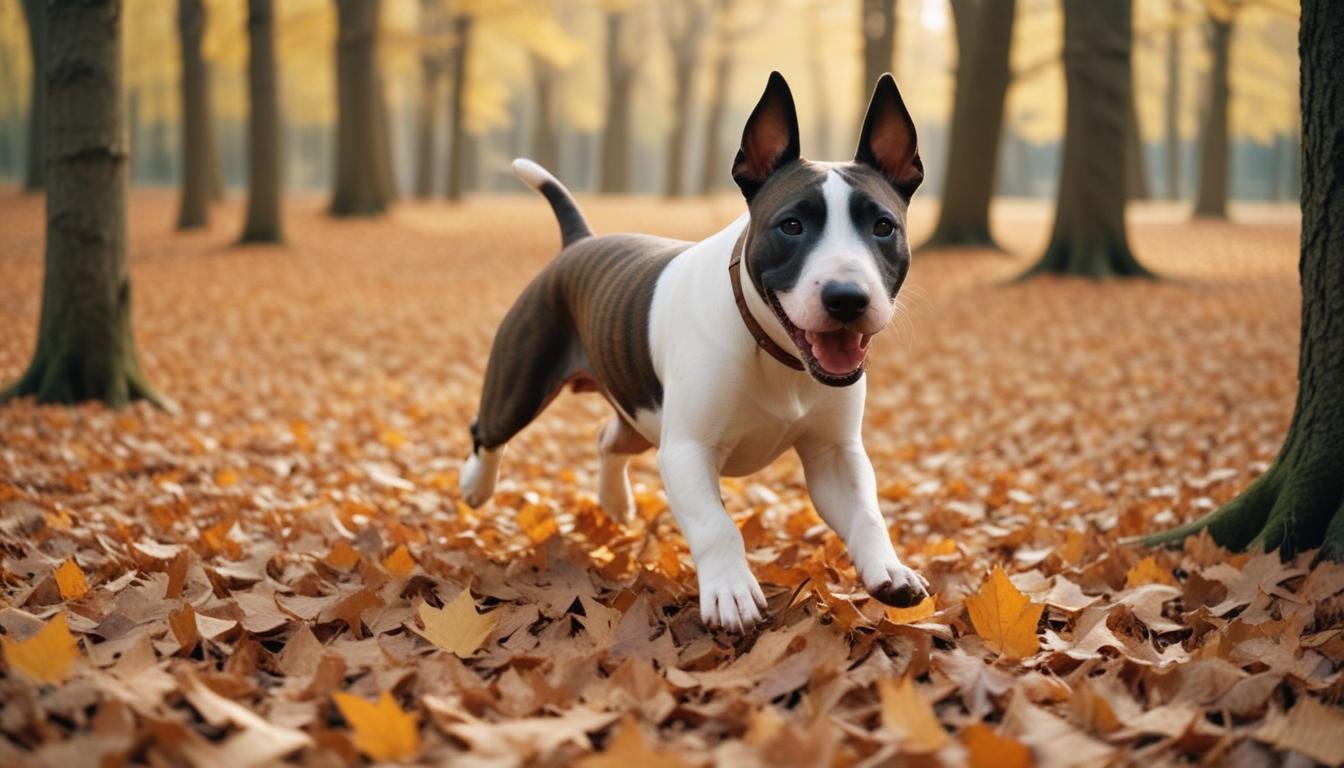
The cost of a Bull Terrier puppy ranges from between $1,200 and $1,500., depending on the breeder and lineage.
17. Do Bull Terriers need supplements?
Supplements like omega-3 fatty acids and joint support formulas can benefit their overall health. Always consult your vet before starting supplements.
18. Are Bull Terriers good for seniors?
Bull Terriers are energetic and strong, making them better suited for active individuals rather than seniors.
19. Can Bull Terriers be left alone?
Bull Terriers are social dogs and may develop destructive behaviors if left alone for long periods. They thrive in homes where they receive plenty of attention.
20. What is the difference between a Bull Terrier and a Miniature Bull Terrier?

- Bull Terrier: Larger, weighing 50-70 pounds and standing 21-22 inches tall.
- Miniature Bull Terrier: Smaller, weighing 20-35 pounds and standing 10-14 inches tall.
Terrier Breeds
Boston Terrier: Covering Article & Brief History

A Comprehensive Guide
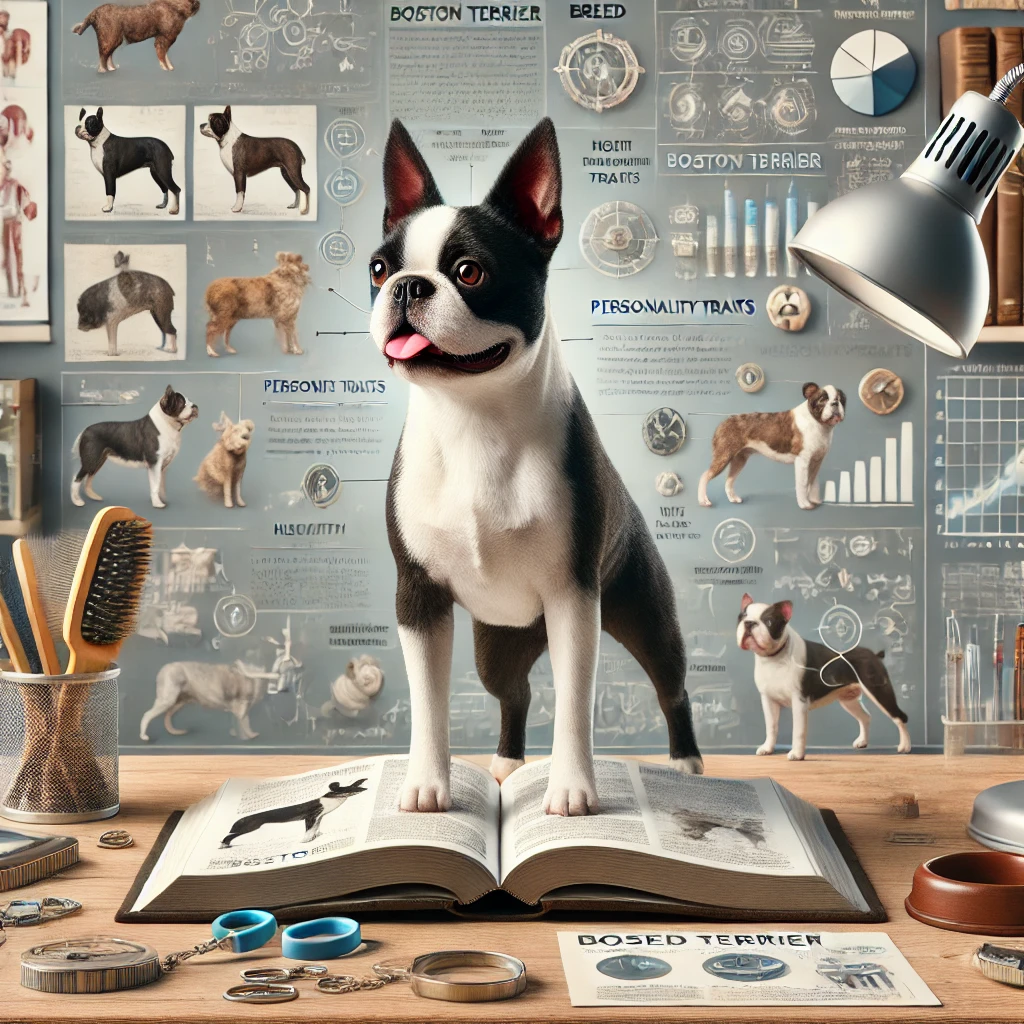
The Boston Terrier, often referred to as the “American Gentleman” due to its tuxedo-like coat, is a small, intelligent, and affectionate breed. This breed originated in the United States in the late 19th century by crossing the English Bulldog with the White English Terrier. The result was a compact, friendly, and sturdy companion dog that quickly gained popularity. Boston Terriers are now beloved worldwide for their friendly demeanor and adaptable nature.
For more information regarding 4 seasonal cxcercieses of all dog breeds recommended by the doctors and experts,you can visit our youtube channel:
Boston Terrier Breed by Country
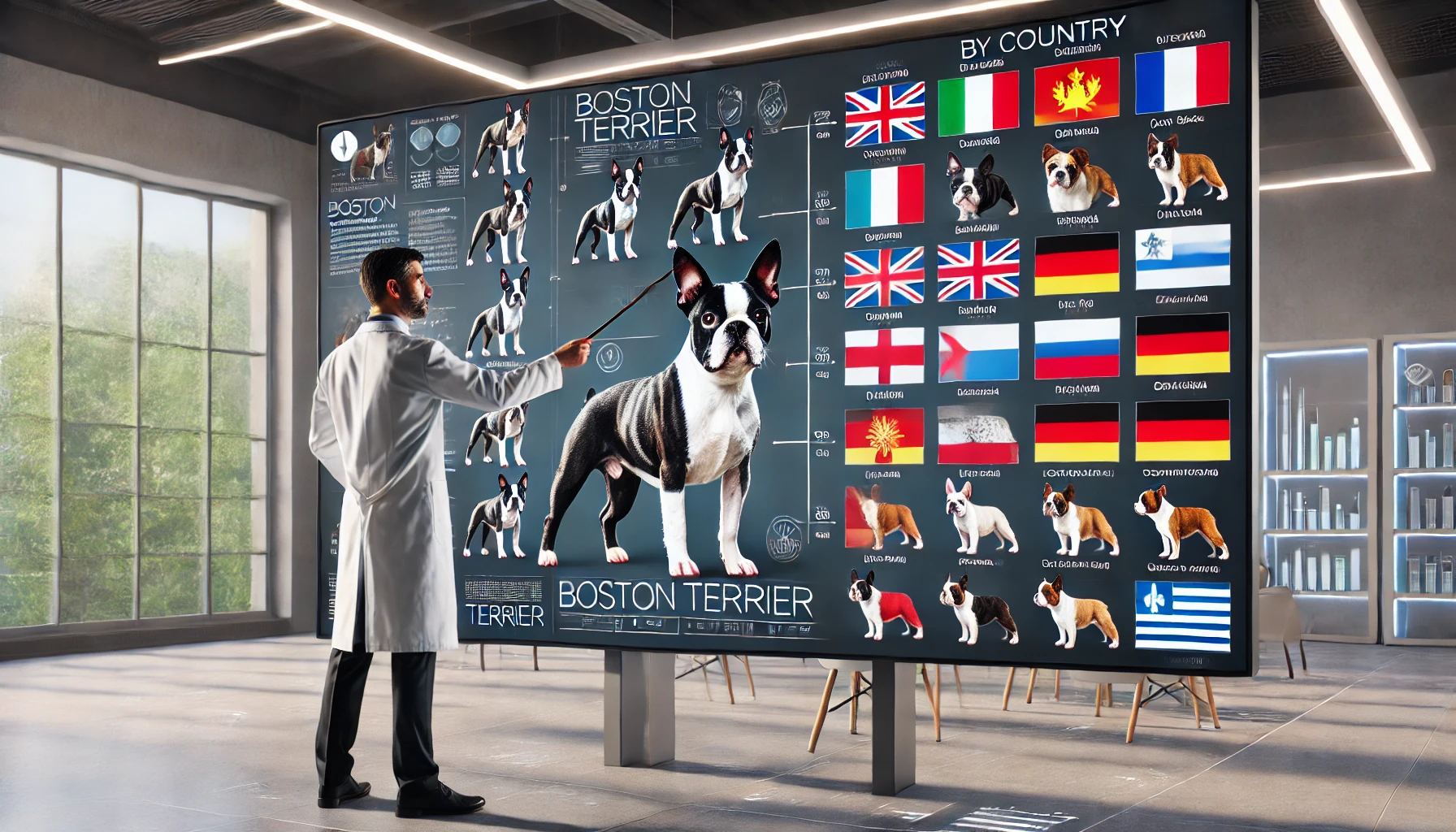
| Country | Breed Standard | Notable Features |
|---|---|---|
| United States | Standard Boston Terrier | Compact, tuxedo coat, friendly |
| United Kingdom | UK Kennel Club Boston Terrier | Slightly smaller, refined features |
| Canada | Canadian Kennel Club Boston Terrier | Moderate size, balanced temperament |
| Australia | Australian National Kennel Council Standard | Similar to US type, adaptable |
Boston Terrier Color Variations by Region
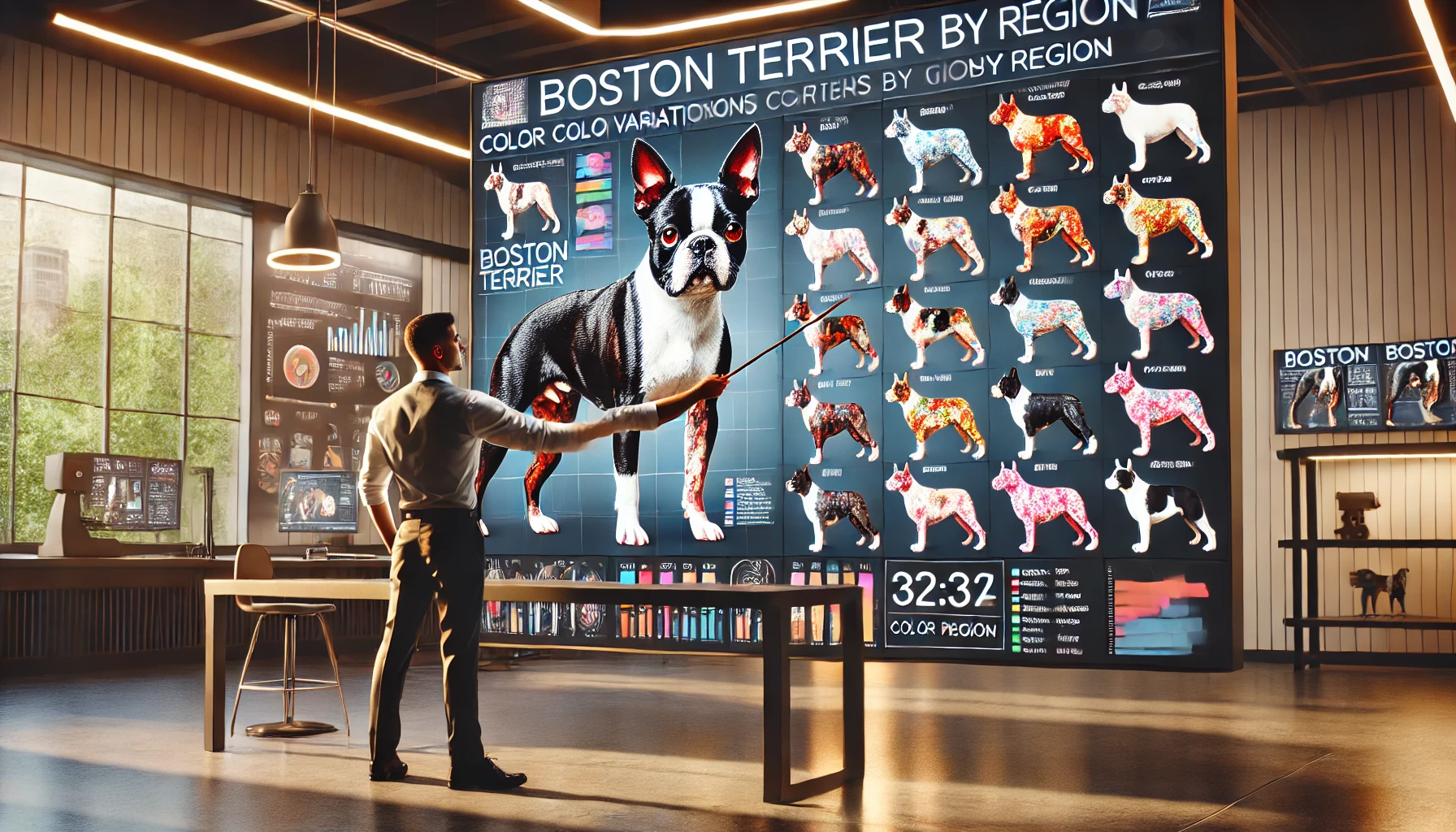
| Region | Accepted Colors |
| United States | Black & White, Brindle & White, Seal & White |
| United Kingdom | Black & White, Brindle & White |
| Canada | Black & White, Brown & White |
| Australia | Black & White, Fawn & White |
Male vs. Female Differences
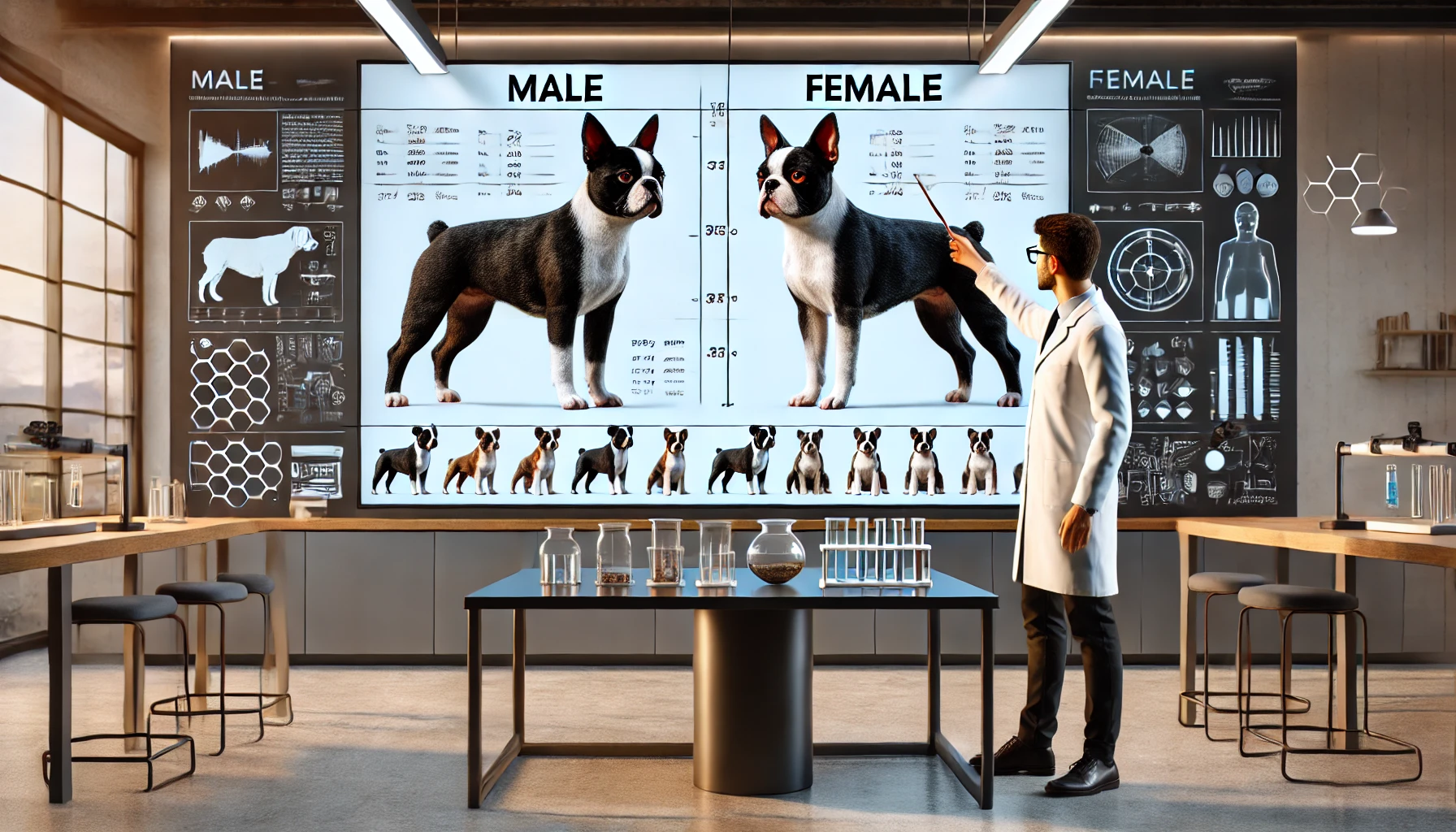
| Feature | Male Boston Terrier | Female Boston Terrier |
| Height | 15-17 inches | 14-16 inches |
| Weight | 12-25 lbs | 10-20 lbs |
| Lifespan | 12-14 years | 13-15 years |
| Temperament | Playful, outgoing | Gentle, affectionate |
| Energy Level | High | Moderate to High |
| Training Ease | Easy | Easy to moderate |
Physical Characteristics
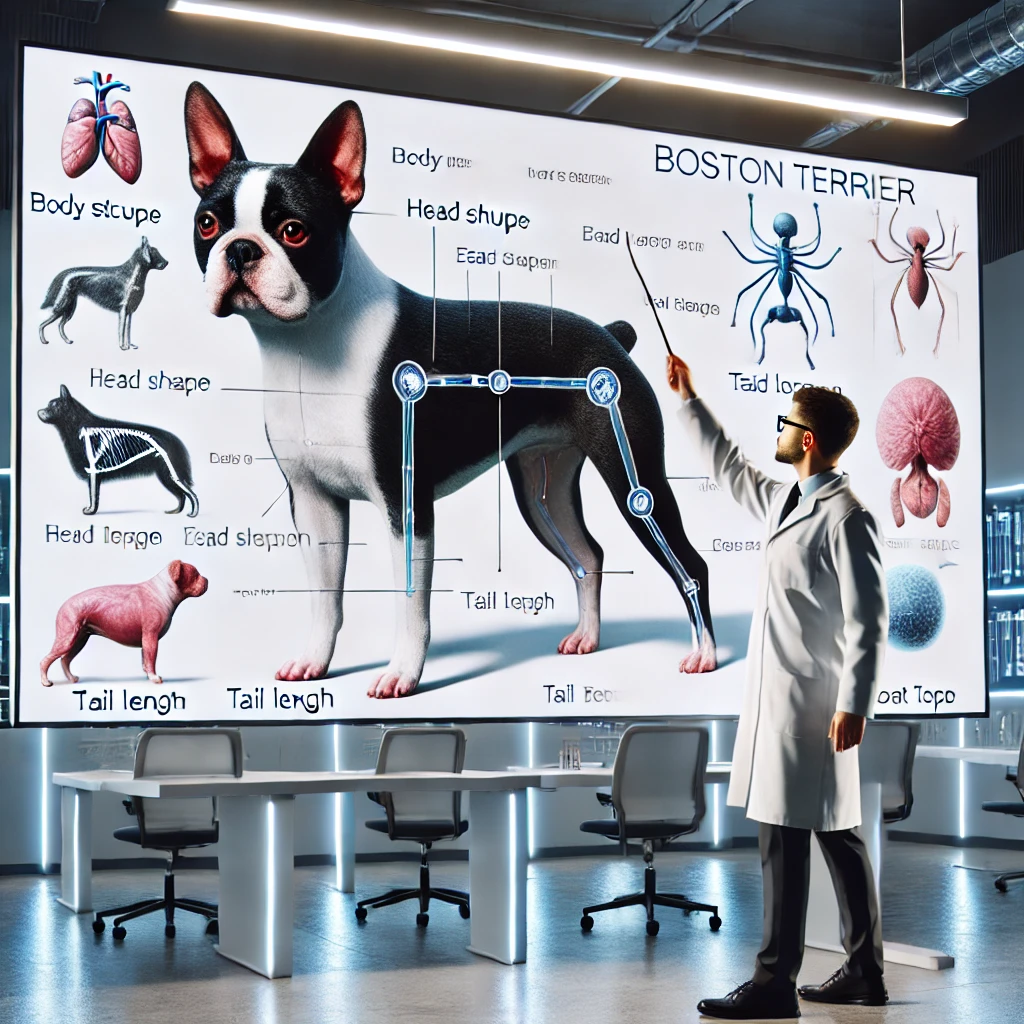
- Height:
- 14-17 inches (depending on gender)
- Weight:
- 10-25 lbs (depending on gender)
- Lifespan:
- 12-15 years
- Coat Type:
- Short, smooth coat requiring minimal grooming
Personality & Temperament

Boston Terriers are known for their:
- Friendly and affectionate nature
- High intelligence, making training easier
- Energetic yet adaptable lifestyle
- Sociability with humans and pets alike
They are excellent companion dogs and adapt well to both apartment living and larger homes.
Grooming Needs
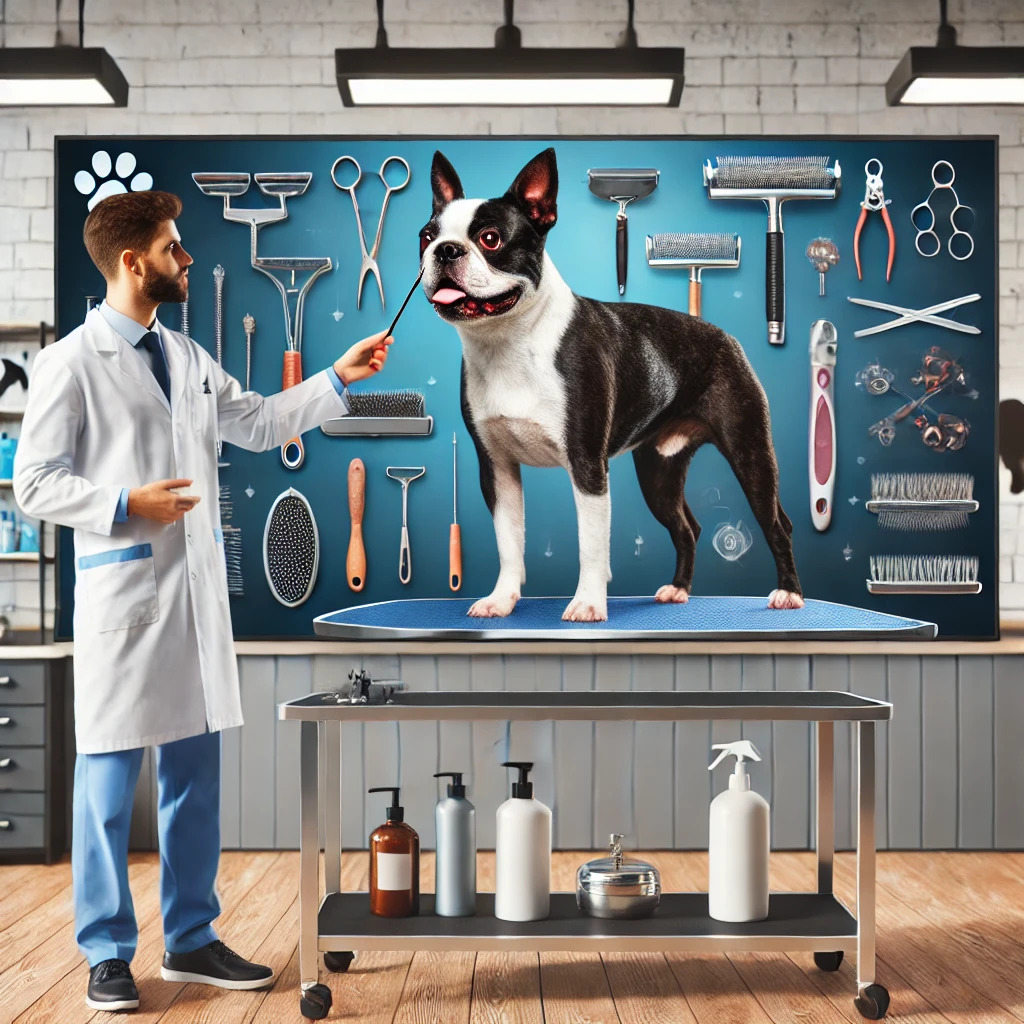
Boston Terriers have a low-maintenance coat but require:
- Weekly brushing to remove loose fur
- Occasional baths to maintain cleanliness
- Regular eye cleaning due to their prominent eyes
- Nail trimming to avoid discomfort
- Exercise Requirements
Boston Terriers are active and require moderate exercise.
Exercise Needs by Gender & Condition

| Category | Recommended Exercise |
| Male Boston Terrier | 30-45 min of daily walks & playtime |
| Pregnant Female | 15-20 min of gentle exercise to prevent stress |
| Non-Pregnant Female | 30 min of moderate walks & interactive play |
Boston Terrier: Seasonal Supplements Table

This table outlines essential supplements for Boston Terriers based on seasonal needs to maintain optimal health.
| Season | Recommended Supplements | Purpose |
|---|---|---|
| Spring | Omega-3 Fatty Acids (Fish Oil),
|
Supports skin & coat health, improves digestion, reduces allergies |
| Summer | Electrolytes,
|
Prevents dehydration, protects paws & skin from heat damage |
| Fall | Joint Supplements (Glucosamine & Chondroitin),
|
Prepares joints for colder months, strengthens immune system |
| Winter | Vitamin D,
|
Supports bone health, prevents dry skin, aids digestion in reduced activity |
Pregnant Female Boston Terrier: Essential Supplements Table

This table outlines the necessary supplements to support the health of a pregnant Boston Terrier and her developing puppies.
| Stage of Pregnancy | Recommended Supplements | Purpose |
|---|---|---|
| Early Pregnancy (Weeks 1-3) | Folic Acid,
|
Supports fetal brain development, improves digestion |
| Mid Pregnancy (Weeks 4-6) | Calcium,
|
Strengthens bones, boosts red blood cell production, enhances immunity |
| Late Pregnancy (Weeks 7-9) | Protein Supplements,
Glucosamine |
Supports milk production, maintains joint health, ensures puppy growth |
| Postpartum & Nursing | Calcium, Omega-3, Probiotics, High-Calorie Supplements | Supports lactation, prevents calcium deficiency, maintains energy levels |
Common Habits of the Boston Terrier

- Energetic & Playful:
- Loves engaging in games and activities.
- Social & Friendly:
- Enjoys human and pet companionship.
- Highly Intelligent:
- Easily trainable and eager to learn.
- Occasionally Stubborn:
- Can be strong-willed, requiring consistent training.
Boston Terriers & Family Compatibility
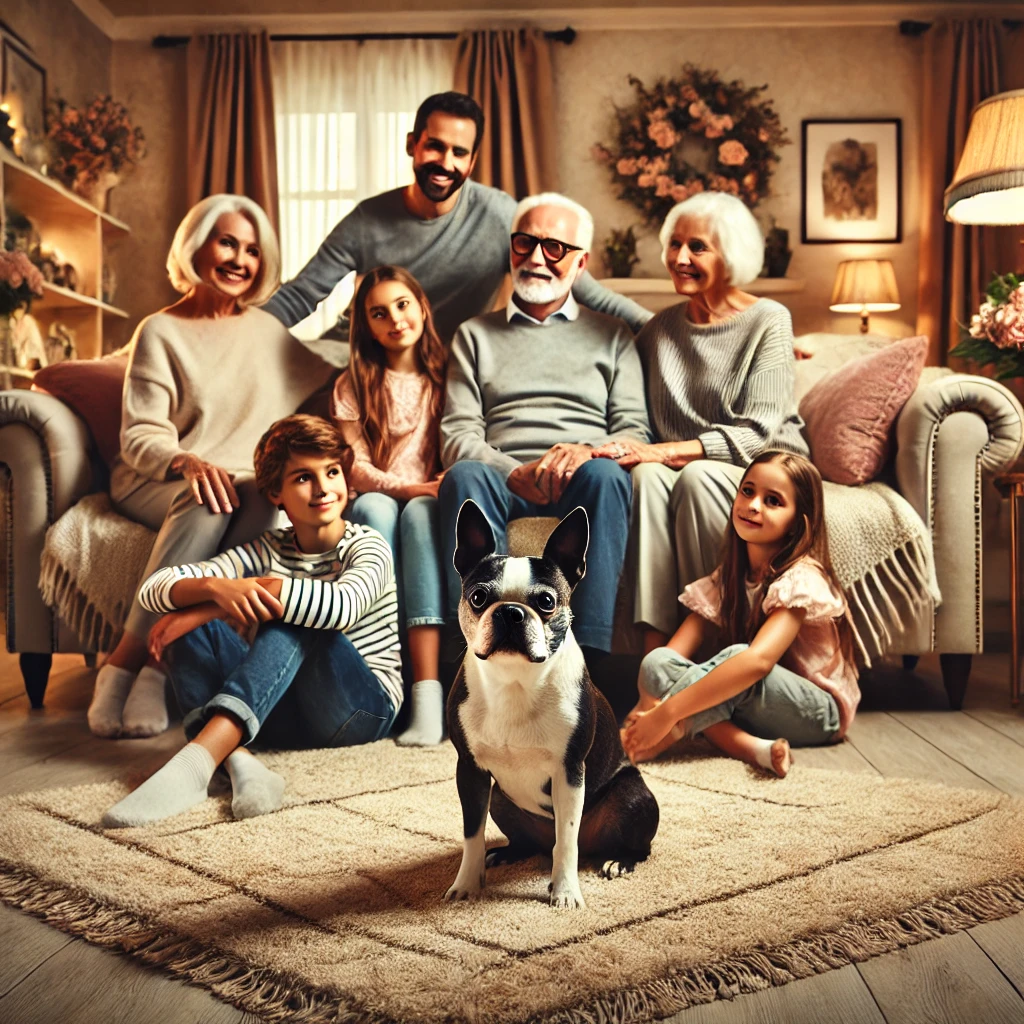
Friendliness with Families & Children
- Families:
- Boston Terriers thrive in family environments and bond closely with their owners.
- Children:
- Excellent with children, particularly when socialized early. Their playful nature makes them great companions for kids.
Closing Statement

The Boston Terrier is a fantastic breed for individuals, families, and seniors alike. With their affectionate temperament, moderate exercise needs, and adaptability, they make exceptional pets. Whether you’re looking for a playful companion or a loving family pet, the Boston Terrier fits the bill perfectly.
(FAQs) About Boston Terriers
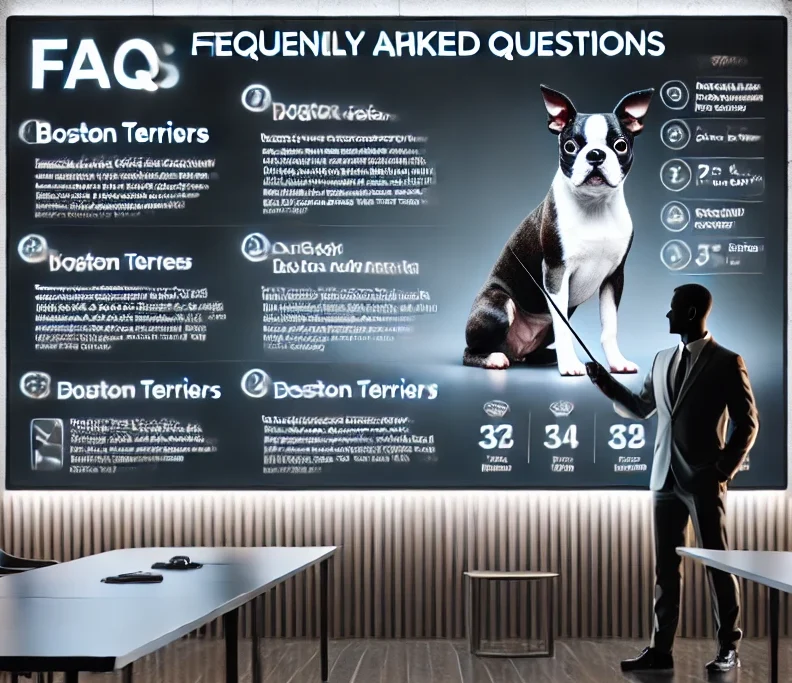
Below are detailed answers to common questions about Boston Terriers, including their temperament, care, and suitability as family pets.
1. What is a Boston Terrier?
The Boston Terrier is a small, lively, and affectionate breed known for its tuxedo-like coat and friendly nature. It is often called the “American Gentleman.”
2. Are Boston Terriers good with children?
Yes, Boston Terriers are gentle, patient, and playful with children, making them excellent family pets.
3. How much exercise does a Boston Terrier need?
Boston Terriers need 30-60 minutes of moderate exercise daily, such as walks, playtime, or interactive games.
4. Are Boston Terriers easy to train?
Yes, Boston Terriers are intelligent and eager to please, making them easy to train. They respond well to positive reinforcement.
5. Do Boston Terriers shed?
Yes, Boston Terriers have a short, smooth coat that sheds moderately. Weekly brushing can help manage shedding.
6. Are Boston Terriers good with other pets?
Yes, Boston Terriers generally get along well with other dogs and pets if socialized early.
7. What is the life span of a Boston Terrier?
The average life span of a Boston Terrier is 11-13 years.
8. Do Boston Terriers bark a lot?
Boston Terriers are not excessive barkers but may bark to alert their owners or when excited.
9. Are Boston Terriers hypoallergenic?
No, Boston Terriers are not hypoallergenic. They shed moderately and may not be suitable for people with severe allergies.
10. What colors do Boston Terriers come in?
Common colors include black and white, brindle and white, and seal and white.
11. Are Boston Terriers good for first-time owners?
Yes, Boston Terriers are friendly, easy to train, and adaptable, making them suitable for first-time owners.
12. How often should I groom my Boston Terrier?
- Brush their coat weekly to remove loose hair.
- Bathe them every 4-6 weeks.
- Clean their ears and trim their nails weekly.
13. Can Boston Terriers live in apartments?
Yes, Boston Terriers are adaptable and do well in apartments as long as they receive daily exercise.
14. Do Boston Terriers have health issues?
Boston Terriers may be prone to:
- Brachycephalic syndrome (breathing difficulties).
- Eye problems (cataracts).
- Allergies.
15. Are Boston Terriers good watchdogs?
Yes, Boston Terriers are alert and will bark to alert their owners of strangers or unusual activity.
16. How much does a Boston Terrier cost?
The cost of a Boston Terrier puppy ranges from between $900 and $2,500, with an average price around $1,300, depending on the breeder and lineage.
17. Do Boston Terriers need supplements?
Supplements like omega-3 fatty acids and joint support formulas can benefit their overall health. Always consult your vet before starting supplements.
18. Are Boston Terriers good for seniors?
Yes, Boston Terriers are affectionate, low-maintenance, and adaptable, making them great companions for seniors.
19. Can Boston Terriers be left alone?
Boston Terriers are social dogs and may develop separation anxiety if left alone for long periods. They thrive in homes where they receive plenty of attention.
20. What is the difference between a Boston Terrier and a French Bulldog?
- Boston Terrier: Smaller, more energetic, and has a tuxedo-like coat.
- French Bulldog: Heavier, more muscular, and has bat-like ears.
-
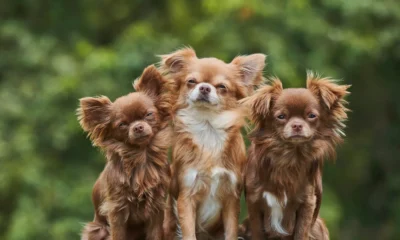
 SMALL DOG BREEDS4 months ago
SMALL DOG BREEDS4 months agoMerle Chihuahua: A Comprehensive Guide
-
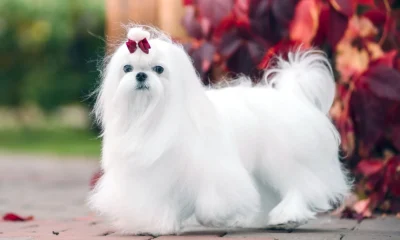
 SMALL DOG BREEDS4 months ago
SMALL DOG BREEDS4 months agoMaltese: A Beloved Companion
-
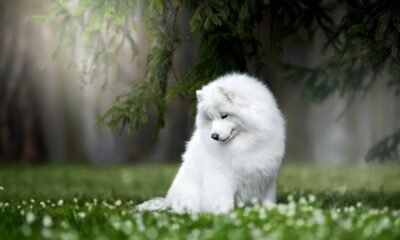
 Large Breeds4 months ago
Large Breeds4 months agoSamoyeds Hypoallergenic: Closer Look at the Breed
-
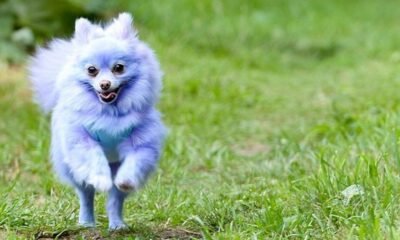
 SMALL DOG BREEDS4 months ago
SMALL DOG BREEDS4 months agoMerle Pomeranian: A Adorable Companion
-

 Large Breeds4 months ago
Large Breeds4 months agoStandard Poodle Weight: Country Wise
-
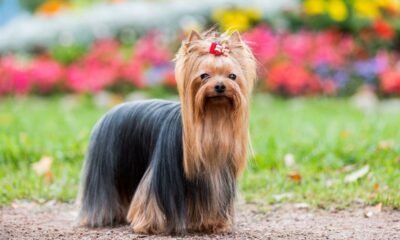
 SMALL DOG BREEDS4 months ago
SMALL DOG BREEDS4 months agoYorkshire Terrier: a Big Personality
-

 MEDIUM BREEDS4 months ago
MEDIUM BREEDS4 months agoAmerican Water Spaniel Colors Chocolate In Crcols:
-

 Terrier Breeds3 months ago
Terrier Breeds3 months agoDog Breeds: by Country & Category











